Exploring the Application Sphere of the Internet of Things in Industry 4.0: A Review, Bibliometric and Content Analysis
Abstract
:1. Introduction
1.1. The Implication of the State-of-Art Review
1.2. Research Questions and Intended Contributions of the Existing Review
1.3. Objectives of the Present Review
- (1)
- To conduct an extensive bibliometric analysis of the existing literature on IoT in Ind 4.0.
- (2)
- To propose a relevant research outlook related to the application of IoT in Ind 4.0 describing its future scope.
2. Materials and Methods
2.1. Research Design
2.2. Inclusive and Exclusive Criteria
2.3. Research Procedure and Software Aid
2.4. Statistical Methods of Data Summarization
3. Scrutiny of Articles, Sources, Authors, Institutions, and Countries: Internet of Things in Industry 4.0 (IoT in Ind 4.0)
3.1. Landscapes of IoT in Ind 4.0 Articles, Yearly Prophecy, and Citations
3.2. The Most Productive and Leading Article Citation Analysis
Literature Survey of Top 25 Cited Documents and Contributions to IoT in Ind 4.0
3.3. The Most Productive and Leading Journal Citation Analysis
3.4. The Most Prolific and Dominant Author Citation Analysis
Lotka’s Function: Author Script Explanation
3.5. Citation Analysis of Organizations and Nations
4. Co-Occurrence of Keyword and Content Analysis
4.1. Co-Occurrence Analysis of Author Keywords in IoT in Ind 4.0
4.2. Index Keywords of IoT in Ind 4.0: Co-Occurrence Analysis
4.3. Text Data Analysis of IoT in Ind 4.0
4.4. Three Field Plots on IoT in Ind 4.0: Sankey Illustrations
5. Latest Trends, Summary, Future Roadmaps, and Concluding Remarks
5.1. Latest Trends in IoT in Ind 4.0
5.2. Summary and Future Roadmaps for IoT in Ind 4.0
- In-depth understanding of IoT and Industry 4.0 ecosystem and applications.
- Optimal interfacing of IoT with other advanced technologies.
- Standardization of protocols for smart industrial processes.
- Developing smart embedded systems.
- Integration of IoT to cater to sustainable development of industrial applications.
- Implementing optimal, productive, flexible, and customized industrial solutions.
5.3. Limitations of Analysis for IoT in Ind 4.0
5.4. Concluding Remarks
Author Contributions
Funding
Institutional Review Board Statement
Informed Consent Statement
Data Availability Statement
Acknowledgments
Conflicts of Interest
References
- Ashton, K. That ‘internet of things’ thing. RFID J. 2009, 22, 97–114. [Google Scholar]
- Haller, S. The Things in the Internet of Things. In Proceedings of the Internet of Things Conference 2010, Tokyo, Japan, 29 November 2010; Volume 5, pp. 26–30. [Google Scholar]
- Haller, S.; Karnouskos, S.; Schroth, C. The Internet of Things in an Enterprise Context; Future Internet Symposium; Springer: Cham, Switzerland, 2008; pp. 14–28. [Google Scholar]
- Casagras, E. Casagras Final Report: Rfid and the Inclusive Model for the Internet of Things. EU FP7 Project CASAGRAS: 2009. Available online: https://docbox.etsi.org/zArchive/TISPAN/Open/IoT/low%20resolution/www.rfidglobal.eu%20CASAGRAS%20IoT%20Final%20Report%20low%20resolution.pdf (accessed on 29 May 2022).
- Rani, S.; Kataria, A.; Sharma, V.; Ghosh, S.; Karar, V.; Lee, K.; Choi, C. Threats and Corrective Measures for IoT Security with Observance of Cybercrime: A Survey. Wirel. Commun. Mob. Comput. 2021, 2021, 5579148. [Google Scholar] [CrossRef]
- Madakam, S.; Lake, V.; Lake, V.; Lake, V. Internet of Things (IoT): A literature review. J. Comput. Commun. 2015, 3, 164. [Google Scholar] [CrossRef] [Green Version]
- Atzori, L.; Iera, A.; Morabito, G. The internet of things: A survey. Comput. Netw. 2010, 54, 2787–2805. [Google Scholar] [CrossRef]
- Lin, J.; Yu, W.; Zhang, N.; Yang, X.; Zhang, H.; Zhao, W. A survey on internet of things: Architecture, enabling technologies, security and privacy, and applications. IEEE Internet Things J. 2017, 4, 1125–1142. [Google Scholar] [CrossRef]
- Forsström, S.; Butun, I.; Eldefrawy, M.; Jennehag, U.; Gidlund, M. Challenges of securing the industrial internet of things value chain. In Proceedings of the 2018 Workshop on Metrology for Industry 4.0 and IoT, Brescia, Italy, 16–18 April 2018; pp. 218–223. [Google Scholar]
- Rani, S.; Gupta, O. CLUS_GPU-BLASTP: Accelerated protein sequence alignment using GPU-enabled cluster. J. Supercomput. 2017, 73, 4580–4595. [Google Scholar] [CrossRef]
- Jeschke, S.; Brecher, C.; Song, H.; Rawat, D. Industrial Internet of Things: Foundations, Principles and Applications; Springer: Cham, Switzerland, 2017; pp. 1–715. [Google Scholar]
- Singh, P.; Gupta, O.; Saini, S. A brief research study of wireless sensor network. Adv. Comput. Sci. Technol. 2017, 10, 733–739. [Google Scholar]
- Aydos, M.; Vural, Y.; Tekerek, A. Assessing risks and threats with layered approach to Internet of Things security. Meas. Control. 2019, 52, 338–353. [Google Scholar] [CrossRef]
- Puri, V.; Kataria, A.; Sharma, V. Artificial intelligence-powered decentralized framework for Internet of Things in Healthcare 4.0. Trans. Emerg. Telecommun. Technol. 2021, e4245. [Google Scholar] [CrossRef]
- Hasnan, N.Z.N.; Yusoff, Y.M. Short Review: Application Areas of Industry 4.0 Technologies in Food Processing Sector. In Proceedings of the 2018 IEEE Student Conference on Research and Development (SCOReD), Selangor, Malaysia, 26–28 November 2018; pp. 1–6. [Google Scholar]
- Bigliardi, B.; Bottani, E.; Casella, G. Enabling technologies, application areas and impact of industry 4.0: A bibliographic analysis. Procedia Manuf. 2020, 42, 322–326. [Google Scholar] [CrossRef]
- Müller, J.M. Business model innovation in small-and medium-sized enterprises: Strategies for industry 4.0 providers and users. J. Manuf. Technol. Manag. 2019, 30, 1127–1142. [Google Scholar] [CrossRef]
- Ebrahimi, M.; Baboli, A.; Rother, E. A Roadmap for evolution of existing production system toward the factory of the future: A case study in automotive industry. In Proceedings of the 2018 IEEE International Conference on Technology Management, Operations and Decisions (ICTMOD), Marrakech, Morocco, 21–23 November 2018; pp. 274–281. [Google Scholar]
- Oztemel, E.; Gursev, S. Literature review of Industry 4.0 and related technologies. J. Intell. Manuf. 2020, 31, 127–182. [Google Scholar] [CrossRef]
- Frank, A.G.; Dalenogare, L.S.; Ayala, N.F. Industry 4.0 technologies: Implementation patterns in manufacturing companies. Int. J. Prod. Econ. 2019, 210, 15–26. [Google Scholar] [CrossRef]
- Dalenogare, L.S.; Benitez, G.B.; Ayala, N.F.; Frank, A.G. The expected contribution of Industry 4.0 technologies for industrial performance. Int. J. Prod. Econ. 2018, 204, 383–394. [Google Scholar] [CrossRef]
- Hasnan, N.N.; Aziz, N.A.; Zulkifli, N.; Taip, F. Food factory design: Reality and challenges faced by Malaysian SMEs. Agric. Agric. Sci. Procedia 2014, 2, 328–336. [Google Scholar] [CrossRef] [Green Version]
- Miśkiewicz, R.; Wolniak, R. Practical Application of the Industry 4.0 Concept in a Steel Company. Sustainability 2020, 12, 5776. [Google Scholar] [CrossRef]
- Javaid, M.; Haleem, A.; Vaishya, R.; Bahl, S.; Suman, R.; Vaish, A. Industry 4.0 technologies and their applications in fighting COVID-19 pandemic. Diabetes Metab. Syndr. Clin. Res. Rev. 2020, 14, 419–422. [Google Scholar] [CrossRef]
- Gusmeroli, S.; Piccione, S.; Rotondi, D. IoT@ Work automation middleware system design and architecture. In Proceedings of 2012 IEEE 17th International Conference on Emerging Technologies & Factory Automation (ETFA 2012), Krakow, Poland, 17–21 September 2012; pp. 1–8. [Google Scholar]
- Ungurean, I.; Gaitan, N.-C.; Gaitan, V.G. An IoT architecture for things from industrial environment. In Proceedings of the 2014 10th International Conference on Communications (COMM), Nicosia, Cyprus, 4–8 August 2014; pp. 1–4. [Google Scholar]
- Okano, M.T. IOT and industry 4.0: The industrial new revolution. In Proceedings of the International Conference on Management and Information Systems September, Istanbul, Turkey, 20 October 2017; p. 26. [Google Scholar]
- Manavalan, E.; Jayakrishna, K. A review of Internet of Things (IoT) embedded sustainable supply chain for industry 4.0 requirements. Comput. Ind. Eng. 2019, 127, 925–953. [Google Scholar] [CrossRef]
- Sisinni, E.; Saifullah, A.; Han, S.; Jennehag, U.; Gidlund, M. Industrial internet of things: Challenges, opportunities, and directions. IEEE Trans. Ind. Inform. 2018, 14, 4724–4734. [Google Scholar] [CrossRef]
- Rathee, G.; Balasaraswathi, M.; Chandran, K.P.; Gupta, S.D.; Boopathi, C. A secure IoT sensors communication in industry 4.0 using blockchain technology. J. Ambient. Intell. Humaniz. Comput. 2021, 12, 533–545. [Google Scholar] [CrossRef]
- Roblek, V.; Meško, M.; Krapež, A. A complex view of industry 4.0. Sage Open 2016, 6, 2158244016653987. [Google Scholar] [CrossRef] [Green Version]
- Xu, L.D.; Xu, E.L.; Li, L. Industry 4.0: State of the art and future trends. Int. J. Prod. Res. 2018, 56, 2941–2962. [Google Scholar] [CrossRef] [Green Version]
- Zhang, C.; Chen, Y. A review of research relevant to the emerging industry trends: Industry 4.0, IoT, blockchain, and business analytics. J. Ind. Integr. Manag. 2020, 5, 165–180. [Google Scholar] [CrossRef]
- Aheleroff, S.; Xu, X.; Lu, Y.; Aristizabal, M.; Velásquez, J.P.; Joa, B.; Valencia, Y. IoT-enabled smart appliances under industry 4.0: A case study. Adv. Eng. Inf. 2020, 43, 101043. [Google Scholar] [CrossRef]
- Muhuri, P.K.; Shukla, A.K.; Abraham, A. Industry 4.0: A bibliometric analysis and detailed overview. Eng. Appl. Artif. Intell. 2019, 78, 218–235. [Google Scholar] [CrossRef]
- Ahmi, A.; Elbardan, H.; Ali, R.H.R.M. Bibliometric analysis of published literature on industry 4.0. In Proceedings of the 2019 International Conference on Electronics, Information, and Communication (ICEIC), Auckland, TX, USA, 22–25 January 2019; pp. 1–6. [Google Scholar]
- Kipper, L.M.; Furstenau, L.B.; Hoppe, D.; Frozza, R.; Iepsen, S. Scopus scientific mapping production in industry 4.0 (2011–2018): A bibliometric analysis. Int. J. Prod. Res. 2020, 58, 1605–1627. [Google Scholar] [CrossRef]
- Borregan-Alvarado, J.; Alvarez-Meaza, I.; Cilleruelo-Carrasco, E.; Garechana-Anacabe, G. A Bibliometric Analysis in Industry 4.0 and Advanced Manufacturing: What about the Sustainable Supply Chain? Sustainability 2020, 12, 7840. [Google Scholar] [CrossRef]
- Bigliardi, B.; Casella, G.; Bottani, E. Industry 4.0 in the logistics field: A bibliometric analysis. IET Collab. Intell. Manuf. 2021, 3, 4–12. [Google Scholar] [CrossRef]
- Velani, A.F.; Narwane, V.S.; Gardas, B.B. Contribution of Internet of things in water supply chain management: A bibliometric and content analysis. J. Model. Manag. 2022. [Google Scholar] [CrossRef]
- Tóth, M.; Felföldi, J.; Várallyai, L.; Szilágyi, R. Application Possibilities of IoT-based Management Systems in Agriculture. In Springer Optimization and Its Applications; Springer: Amsterdam, The Netherlands, 2022; Volume 183, pp. 77–102. [Google Scholar]
- Rani, S.; Kataria, A.; Chauhan, M.; Rattan, P.; Kumar, R.; Kumar Sivaraman, A. Security and Privacy Challenges in the Deployment of Cyber-Physical Systems in Smart City Applications: State-of-Art Work. Mater. Today Proc. 2022; in press. [Google Scholar] [CrossRef]
- Jeflea, F.V.; Danciulescu, D.; Sitnikov, C.S.; Filipeanu, D.; Park, J.O.; Tugui, A. Societal Technological Megatrends: A Bibliometric Analysis from 1982 to 2021. Sustainability 2022, 14, 1543. [Google Scholar] [CrossRef]
- Li, K.C.; Wong, B.T.M. Research landscape of smart education: A bibliometric analysis. Interact. Technol. Smart Educ. 2022, 19, 3–19. [Google Scholar] [CrossRef]
- Raza, S.A. A systematic literature review of RFID in supply chain management. J. Enterp. Inf. Manag. 2022, 35, 617–649. [Google Scholar] [CrossRef]
- Hassan, A.; Afrouzi, H.N.; Siang, C.H.; Ahmed, J.; Mehranzamir, K.; Wooi, C.L. A survey and bibliometric analysis of different communication technologies available for smart meters. Clean. Eng. Technol. 2022, 7, 100424. [Google Scholar] [CrossRef]
- Rosário, A.T.; Dias, J.C. Sustainability and the Digital Transition: A Literature Review. Sustainability 2022, 14, 4027. [Google Scholar] [CrossRef]
- Rani, S.; Kumar, R. Bibliometric review of actuators: Key automation technology in a smart city framework. Mater. Today Proc. 2022, 60, 1800–1807. [Google Scholar] [CrossRef]
- Sidhu, A.S.; Singh, S.; Kumar, R. Bibliometric analysis of entropy weights method for multi-objective optimization in machining operations. Mater. Today Proc. 2022, 50, 1248–1255. [Google Scholar] [CrossRef]
- Ashraf, R.; Khan, M.A.; Khuhro, R.A.; Bhatti, Z.A. Knowledge creation dynamics of technological forecasting and social change special issues. Technol. Forecast. Soc. Change 2022, 180, 121663. [Google Scholar] [CrossRef]
- Pritchard, A. Statistical bibliography or bibliometrics. J. Doc. 1969, 25, 348–349. [Google Scholar]
- Donthu, N.; Kumar, S.; Mukherjee, D.; Pandey, N.; Lim, W.M. How to conduct a bibliometric analysis: An overview and guidelines. J. Bus. Res. 2021, 133, 285–296. [Google Scholar] [CrossRef]
- Moral-Muñoz, J.A.; Herrera-Viedma, E.; Santisteban-Espejo, A.; Cobo, M.J. Software tools for conducting bibliometric analysis in science: An up-to-date review. Prof. Inf. 2020, 29, e290103. [Google Scholar] [CrossRef] [Green Version]
- Chandel, R.S.; Sharma, S.; Kaur, S.; Singh, S.; Kumar, R. Smart watches: A review of evolution in bio-medical sector. Mater. Today Proc. 2022, 50, 1053–1066. [Google Scholar] [CrossRef]
- Kumar, R.; Goel, P. Exploring the Domain of Interpretive Structural Modelling (ISM) for Sustainable Future Panorama: A Bibliometric and Content Analysis. Arch. Comput. Methods Eng. 2021, 1–30. [Google Scholar] [CrossRef]
- Van Eck, N.J.; Waltman, L. Software survey: VOSviewer, a computer program for bibliometric mapping. Scientometrics 2010, 84, 523–538. [Google Scholar] [CrossRef] [Green Version]
- Aria, M. bibliometrix: An R-tool for comprehensive science mapping analysis. J. Informetr. 2017, 11, 959–975. [Google Scholar] [CrossRef]
- Van Eck, N.J.; Waltman, L. How to Normalize Cooccurrence Data? An Analysis of Some Well-Known Similarity Measures. JASIST 2009, 60, 1635–1651. [Google Scholar]
- Zhong, R.Y.; Xu, X.; Klotz, E.; Newman, S.T. Intelligent manufacturing in the context of industry 4.0: A review. Engineering 2017, 3, 616–630. [Google Scholar] [CrossRef]
- Hofmann, E.; Rüsch, M. Industry 4.0 and the current status as well as future prospects on logistics. Comput. Ind. 2017, 89, 23–34. [Google Scholar] [CrossRef]
- Wollschlaeger, M.; Sauter, T.; Jasperneite, J. The future of industrial communication: Automation networks in the era of the internet of things and industry 4.0. IEEE Ind. Electron. Mag. 2017, 11, 17–27. [Google Scholar] [CrossRef]
- Kang, H.S.; Lee, J.Y.; Choi, S.; Kim, H.; Park, J.H.; Son, J.Y.; Kim, B.H.; Noh, S.D. Smart manufacturing: Past research, present findings, and future directions. Int. J. Precis. Eng. Manuf. Green Technol. 2016, 3, 111–128. [Google Scholar] [CrossRef]
- Wan, J.; Tang, S.; Shu, Z.; Li, D.; Wang, S.; Imran, M.; Vasilakos, A.V. Software-Defined Industrial Internet of Things in the Context of Industry 4.0. IEEE Sens. J. 2016, 16, 7373–7380. [Google Scholar] [CrossRef]
- Chen, B.; Wan, J.; Shu, L.; Li, P.; Mukherjee, M.; Yin, B. Smart Factory of Industry 4.0: Key Technologies, Application Case, and Challenges. IEEE Access 2018, 6, 6505–6519. [Google Scholar] [CrossRef]
- Tao, F.; Zhang, M. Digital twin shop-floor: A new shop-floor paradigm towards smart manufacturing. IEEE Access 2017, 5, 20418–20427. [Google Scholar] [CrossRef]
- Moeuf, A.; Pellerin, R.; Lamouri, S.; Tamayo-Giraldo, S.; Barbaray, R. The industrial management of SMEs in the era of Industry 4.0. Int. J. Prod. Res. 2018, 56, 1118–1136. [Google Scholar] [CrossRef] [Green Version]
- Wan, J.; Lai, C.-F.; Song, H.; Imran, M.; Jia, D. Software-Defined Industrial Internet of Things; Hindawi: London, UK, 2019. [Google Scholar]
- Sanders, A.; Elangeswaran, C.; Wulfsberg, J.P. Industry 4.0 implies lean manufacturing: Research activities in industry 4.0 function as enablers for lean manufacturing. J. Ind. Eng. Manag. JIEM 2016, 9, 811–833. [Google Scholar] [CrossRef] [Green Version]
- Kamble, S.S.; Gunasekaran, A.; Gawankar, S.A. Sustainable Industry 4.0 framework: A systematic literature review identifying the current trends and future perspectives. Process Saf. Environ. Prot. 2018, 117, 408–425. [Google Scholar] [CrossRef]
- Boyes, H.; Hallaq, B.; Cunningham, J.; Watson, T. The industrial internet of things (IIoT): An analysis framework. Comput. Ind. 2018, 101, 1–12. [Google Scholar] [CrossRef]
- Müller, J.M.; Kiel, D.; Voigt, K.-I. What drives the implementation of Industry 4.0? The role of opportunities and challenges in the context of sustainability. Sustainability 2018, 10, 247. [Google Scholar] [CrossRef] [Green Version]
- De Sousa Jabbour, A.B.L.; Jabbour, C.J.C.; Godinho Filho, M.; Roubaud, D. Industry 4.0 and the circular economy: A proposed research agenda and original roadmap for sustainable operations. Ann. Oper. Res. 2018, 270, 273–286. [Google Scholar] [CrossRef]
- Pereira, A.C.; Romero, F. A review of the meanings and the implications of the Industry 4.0 concept. Procedia Manuf. 2017, 13, 1206–1214. [Google Scholar] [CrossRef]
- Buer, S.-V.; Strandhagen, J.O.; Chan, F.T. The link between Industry 4.0 and lean manufacturing: Mapping current research and establishing a research agenda. Int. J. Prod. Res 2018, 56, 2924–2940. [Google Scholar] [CrossRef] [Green Version]
- Xu, L.D.; Duan, L. Big data for cyber physical systems in industry 4.0: A survey. Enterp. Inf. Syst. 2019, 13, 148–169. [Google Scholar] [CrossRef]
- Kiel, D.; Müller, J.M.; Arnold, C.; Voigt, K.-I. Sustainable industrial value creation: Benefits and challenges of industry 4.0. In Digital Disruptive Innovation; World Scientific: Singapore, 2020; pp. 231–270. [Google Scholar]
- Barreto, L.; Amaral, A.; Pereira, T. Industry 4.0 implications in logistics: An overview. Procedia Manuf. 2017, 13, 1245–1252. [Google Scholar] [CrossRef]
- Haseeb, M.; Hussain, H.I.; Ślusarczyk, B.; Jermsittiparsert, K. Industry 4.0: A solution towards technology challenges of sustainable business performance. Soc. Sci. 2019, 8, 154. [Google Scholar] [CrossRef] [Green Version]
- Aazam, M.; Zeadally, S.; Harras, K.A. Deploying fog computing in industrial internet of things and industry 4.0. IEEE Trans. Ind. Inform. 2018, 14, 4674–4682. [Google Scholar] [CrossRef]
- Yin, Y.; Stecke, K.E.; Li, D. The evolution of production systems from Industry 2.0 through Industry 4.0. Int. J. Prod. Res. 2018, 56, 848–861. [Google Scholar] [CrossRef] [Green Version]
- Schroeder, G.N.; Steinmetz, C.; Pereira, C.E.; Espindola, D.B. Digital twin data modeling with automationml and a communication methodology for data exchange. IFAC PapersOnLine 2016, 49, 12–17. [Google Scholar] [CrossRef]
- Sommer, L. Industrial revolution-industry 4.0: Are German manufacturing SMEs the first victims of this revolution? J. Ind. Eng. Manag. 2015, 8, 1512–1532. [Google Scholar] [CrossRef] [Green Version]
- Lotka, A.J. The frequency distribution of scientific productivity. J. Wash. Acad. Sci. 1926, 16, 317–323. [Google Scholar]
- Egghe, L. Relations between the continuous and the discrete Lotka power function. J. Am. Soc. Inf. Sci. Technol. 2005, 56, 664–668. [Google Scholar] [CrossRef]
- Kumar, R.; Singh, S.; Sidhu, A.S.; Pruncu, C.I. Bibliometric Analysis of Specific Energy Consumption (SEC) in Machining Operations: A Sustainable Response. Sustainability 2021, 13, 5617. [Google Scholar] [CrossRef]
- Van Eck, N.J.W. Text mining and visualization using VOSviewer. ISSI Newsl. 2011, 7, 50–54. [Google Scholar]
- Riehmann, P.; Hanfler, M.; Froehlich, B. Interactive Sankey diagrams. In Proceedings of the IEEE Symposium on Information Visualization, 2005. INFOVIS 2005, Minneapolis, MN, USA, 23–25 October 2005; pp. 233–240. [Google Scholar]
- Stahlschmidt, S.; Stephen, D. Comparison of Web of Science, Scopus and Dimensions Databases; KB Forschungspoolprojekt, DZHW: Hannover, Germany, 2020. [Google Scholar]
- Vieira, E.; Ferreira Gomes, J. A comparison of Scopus and Web of Science for a typical university. Scientometrics 2009, 81, 587–600. [Google Scholar] [CrossRef]
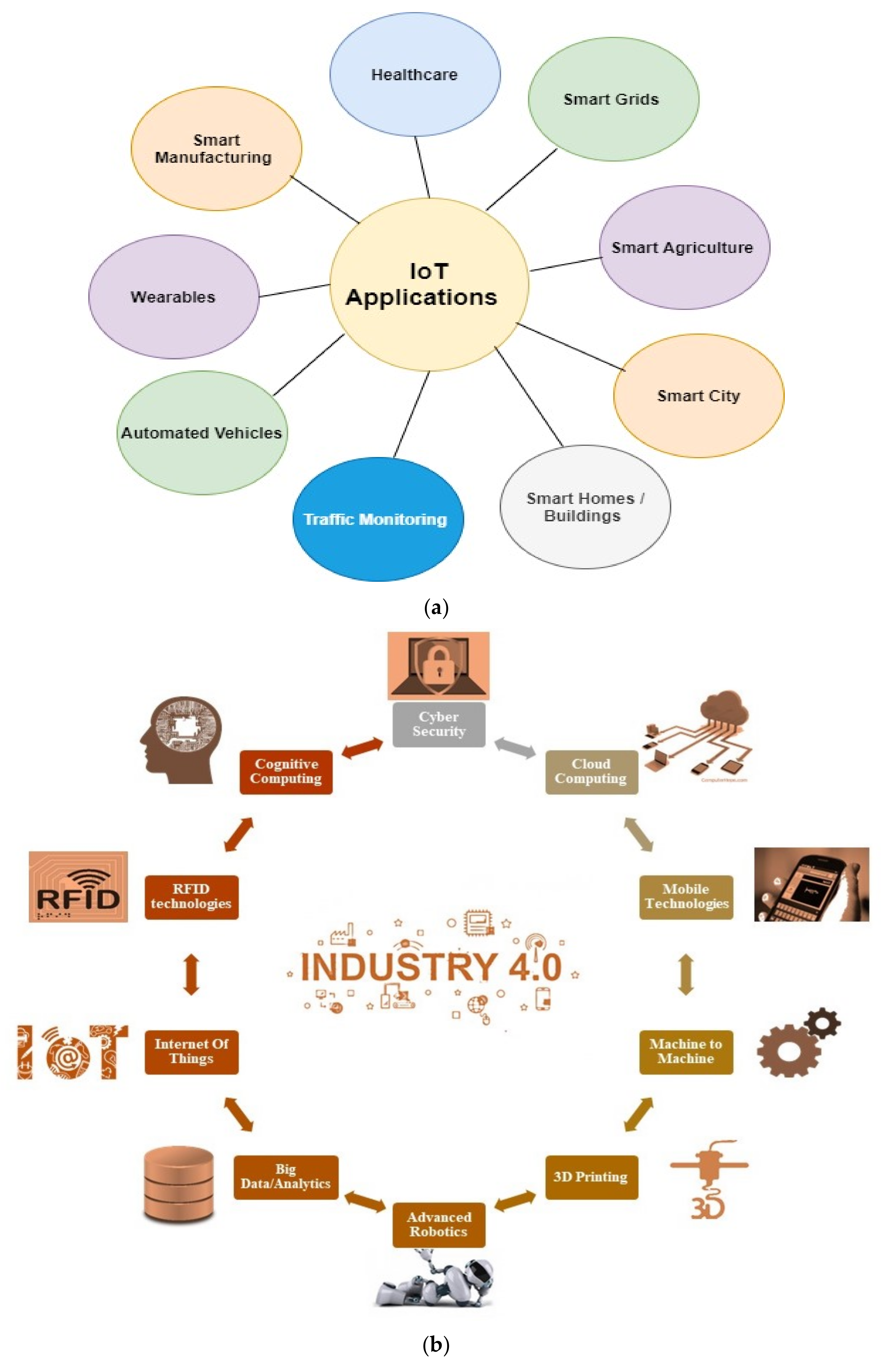
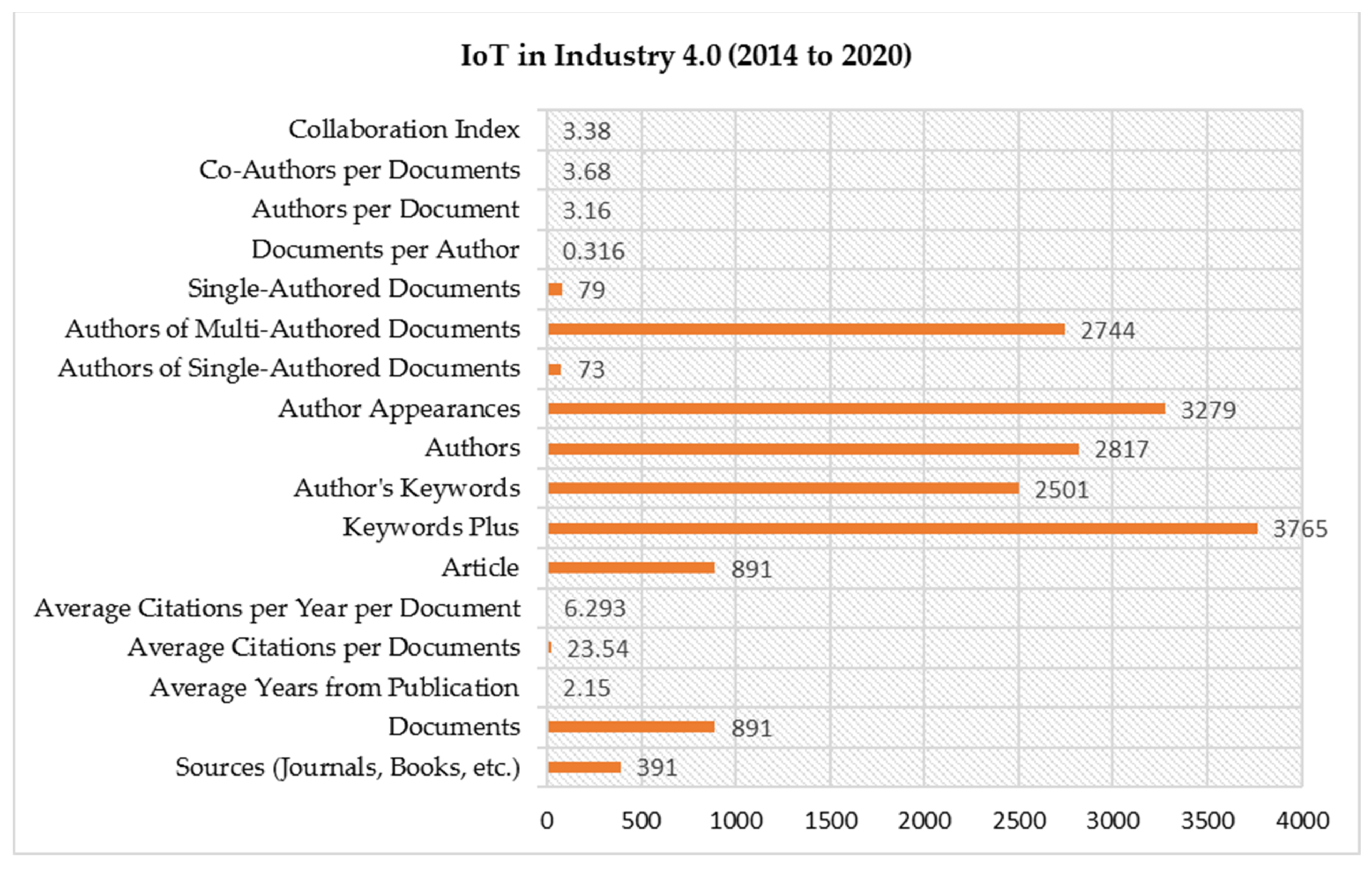

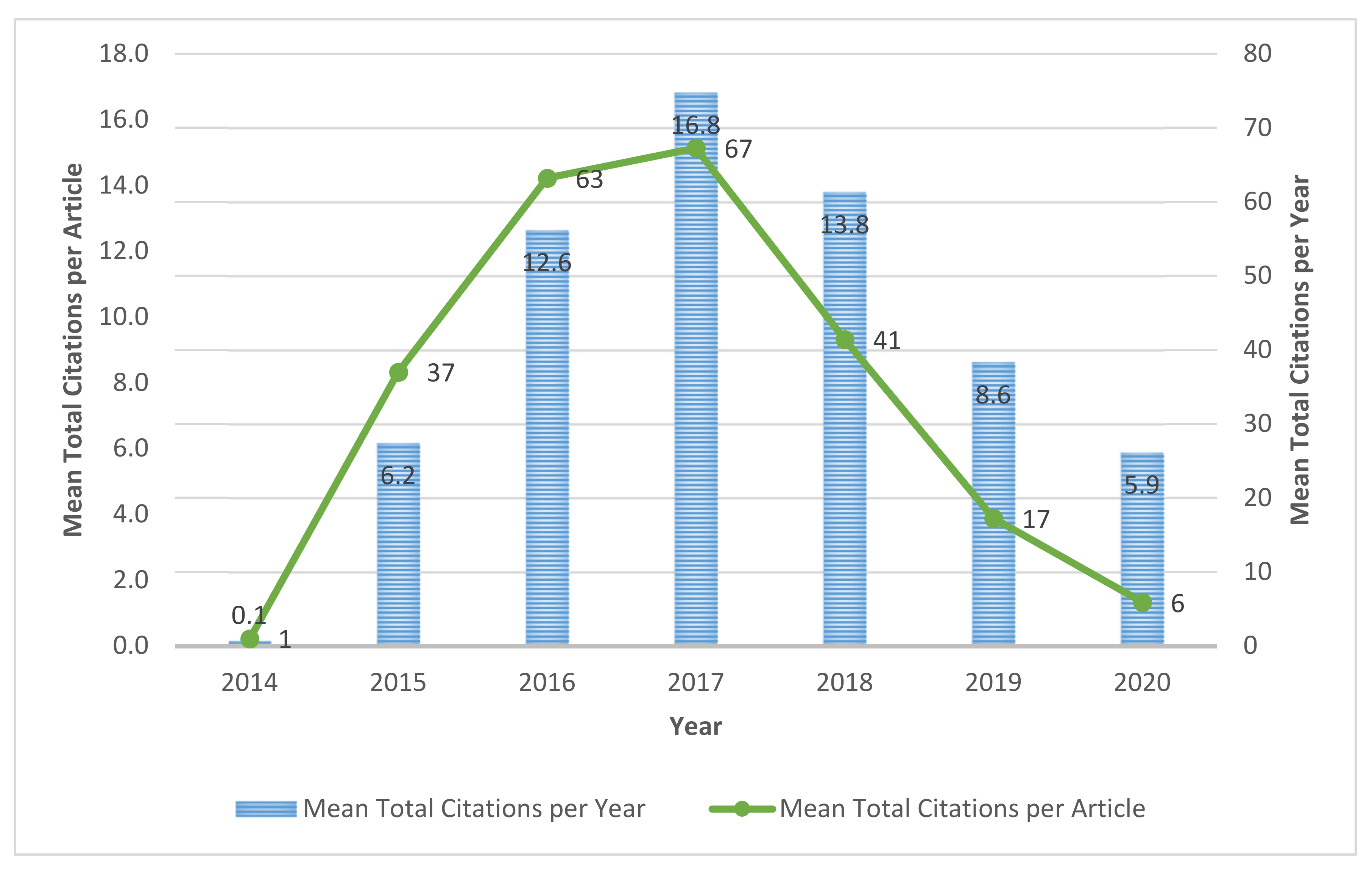
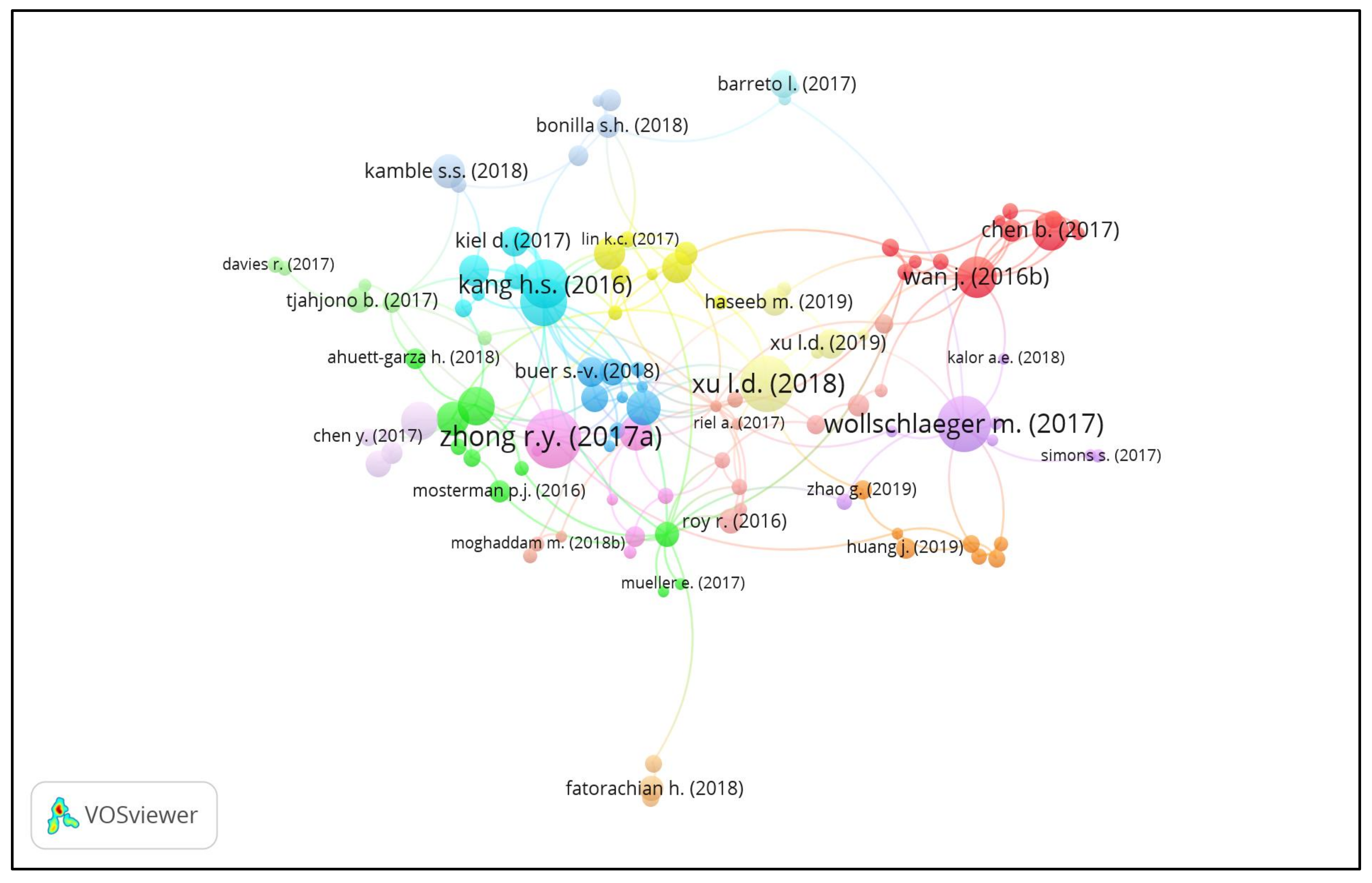

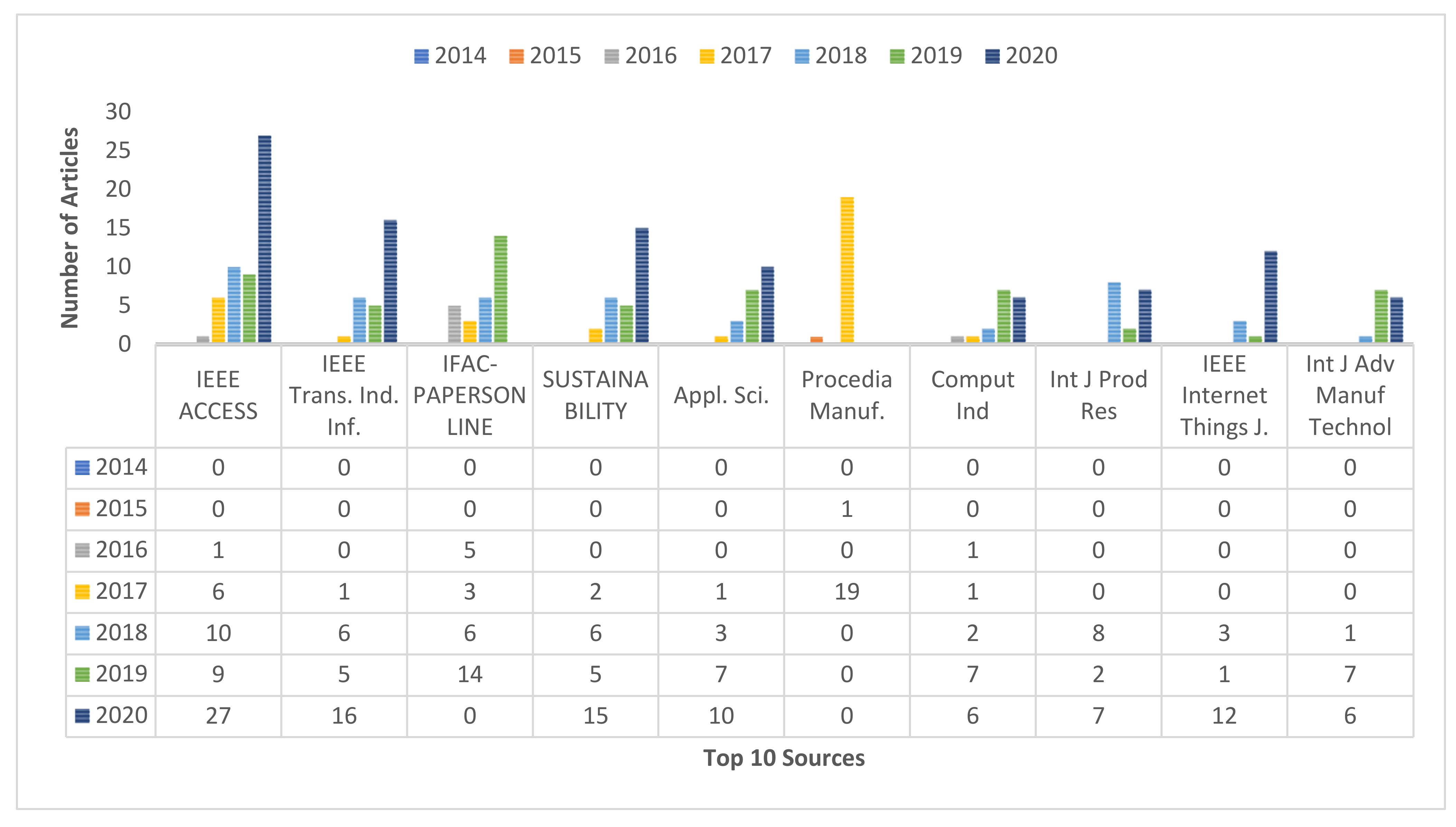
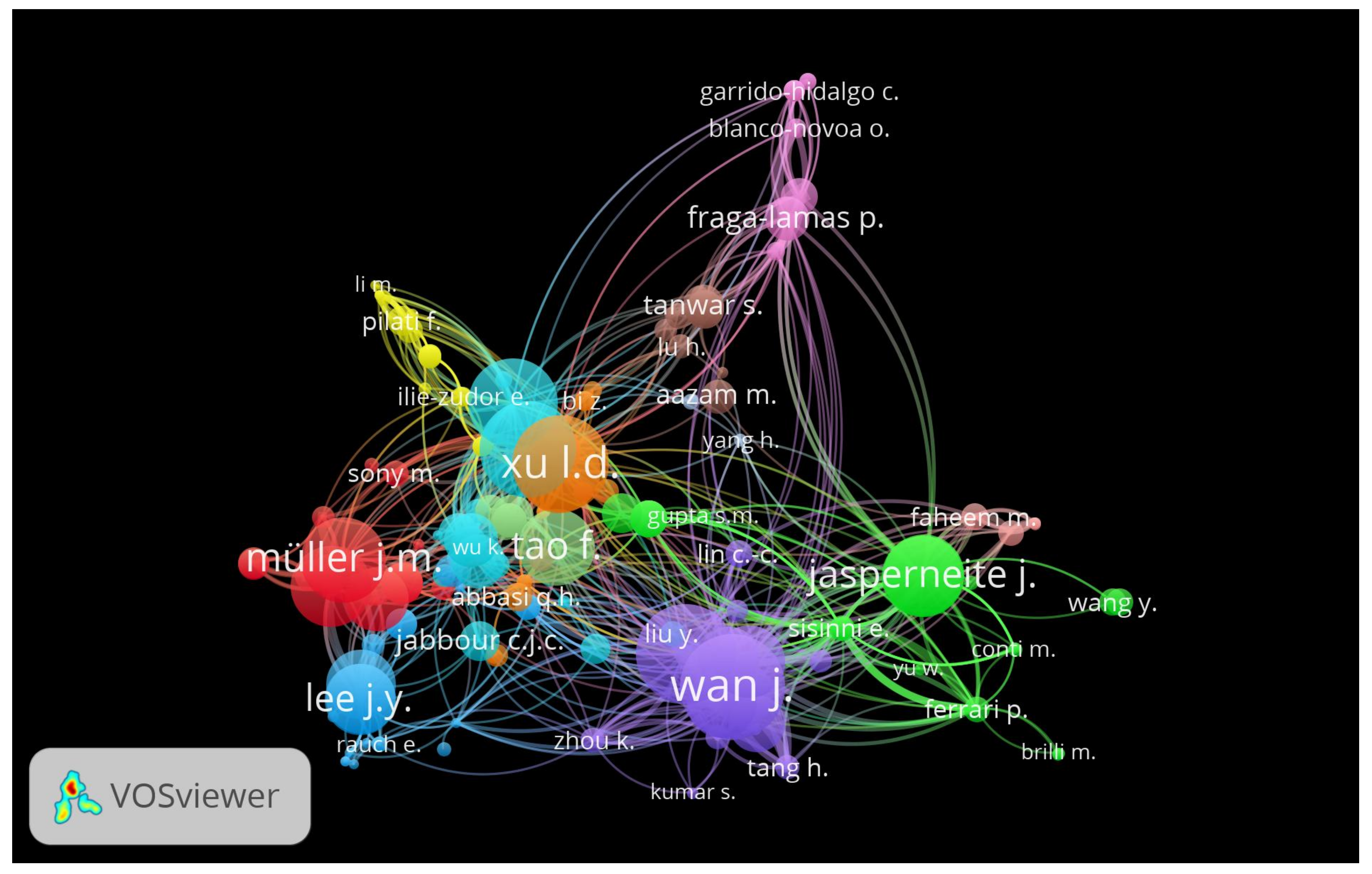
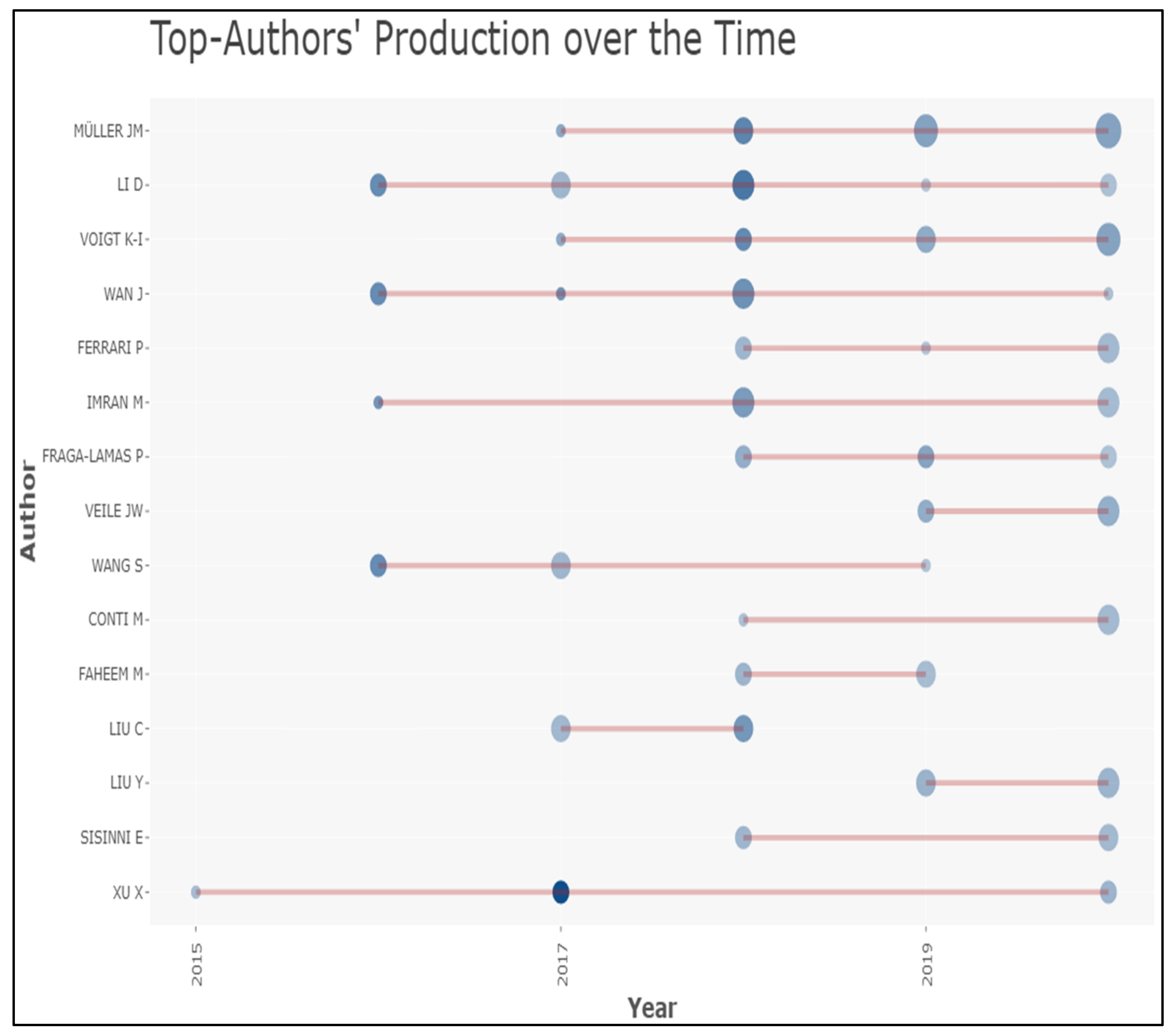
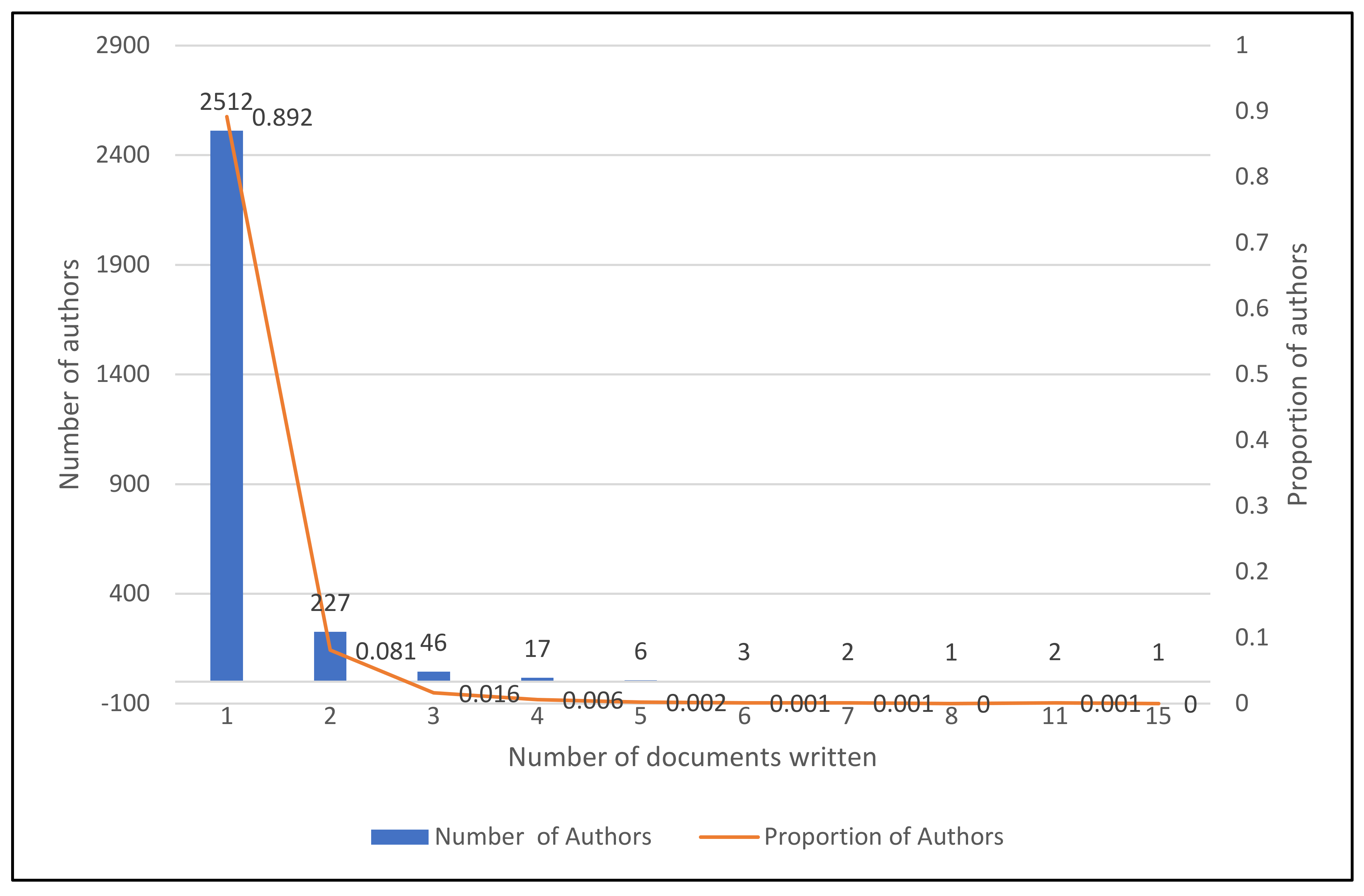

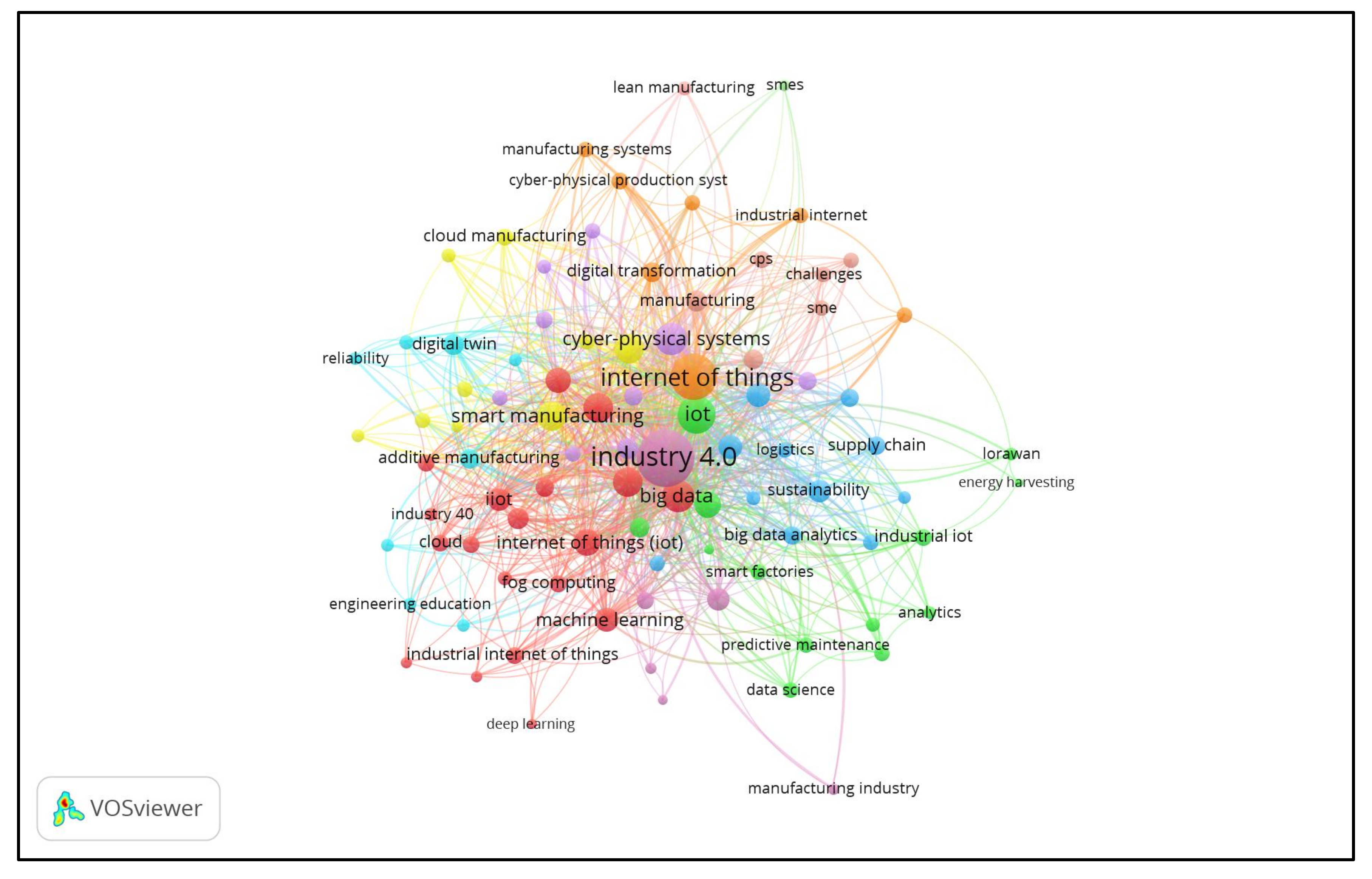
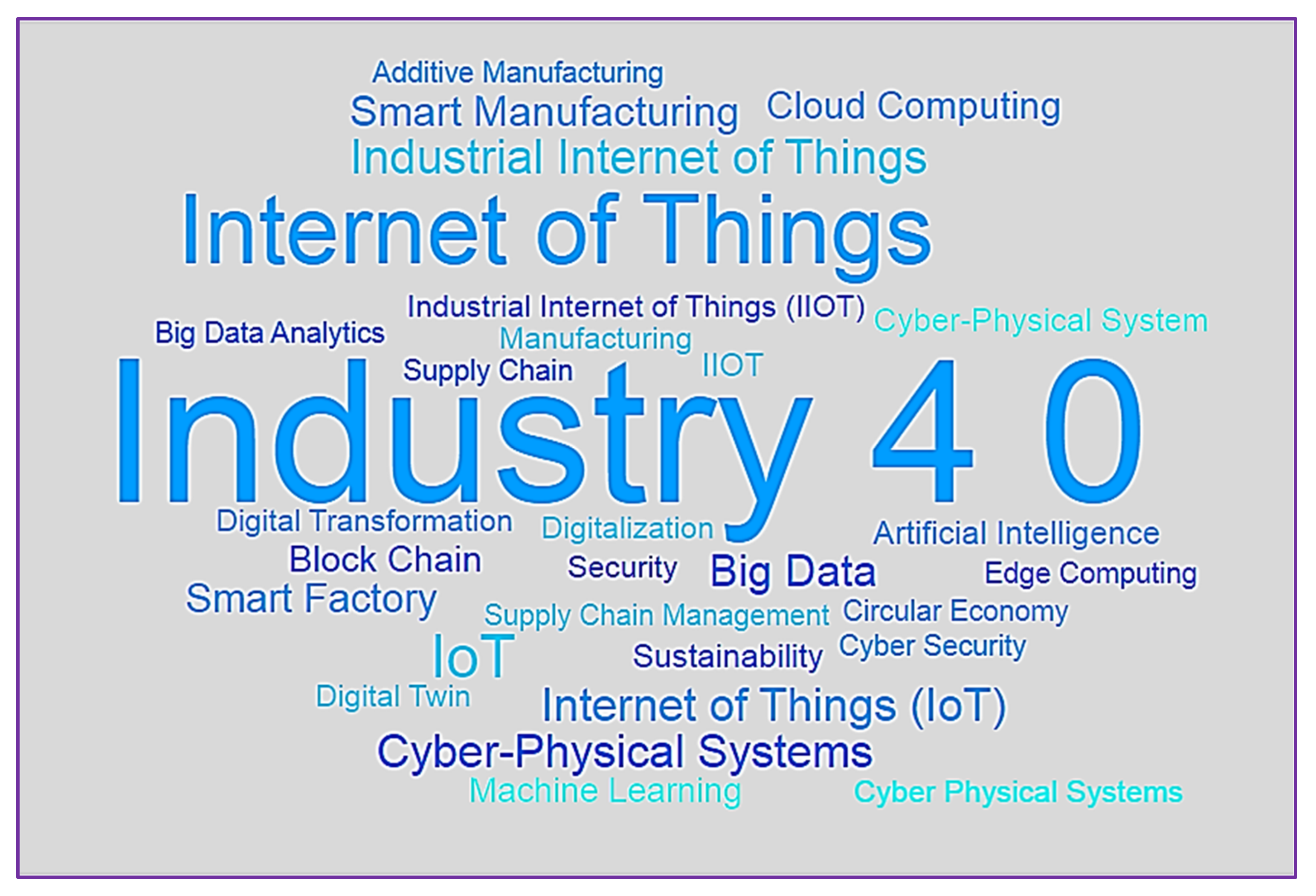

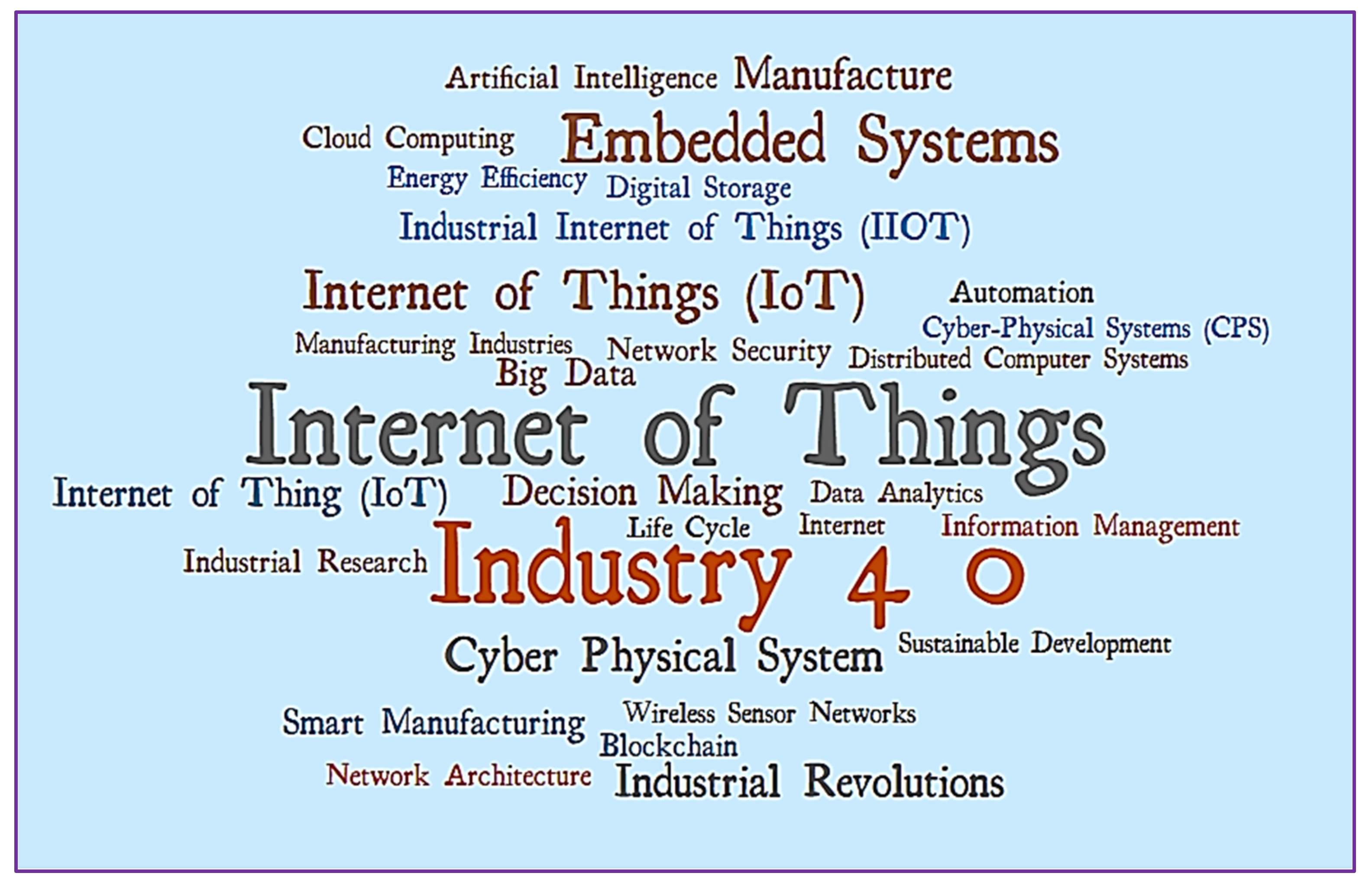
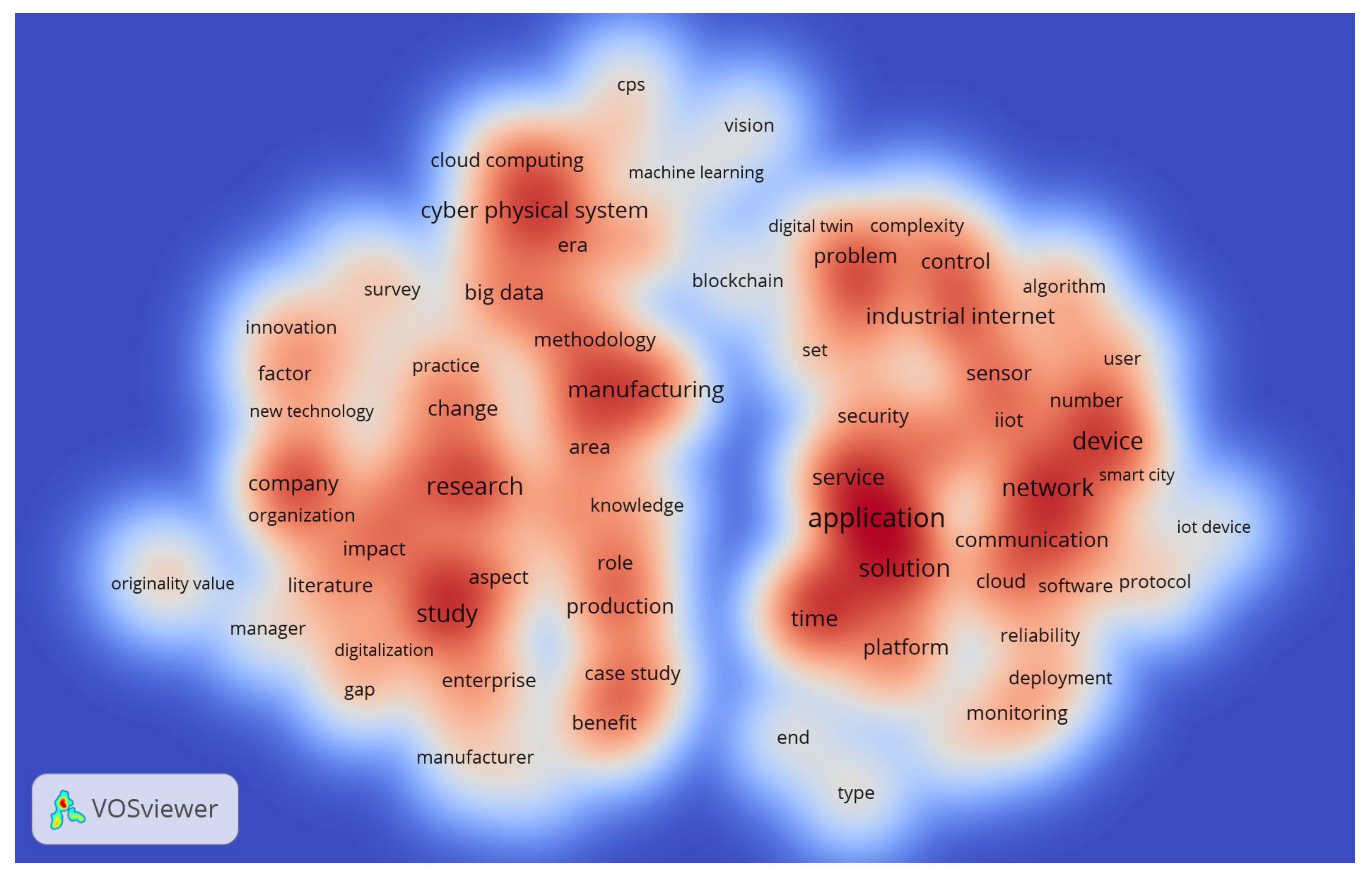

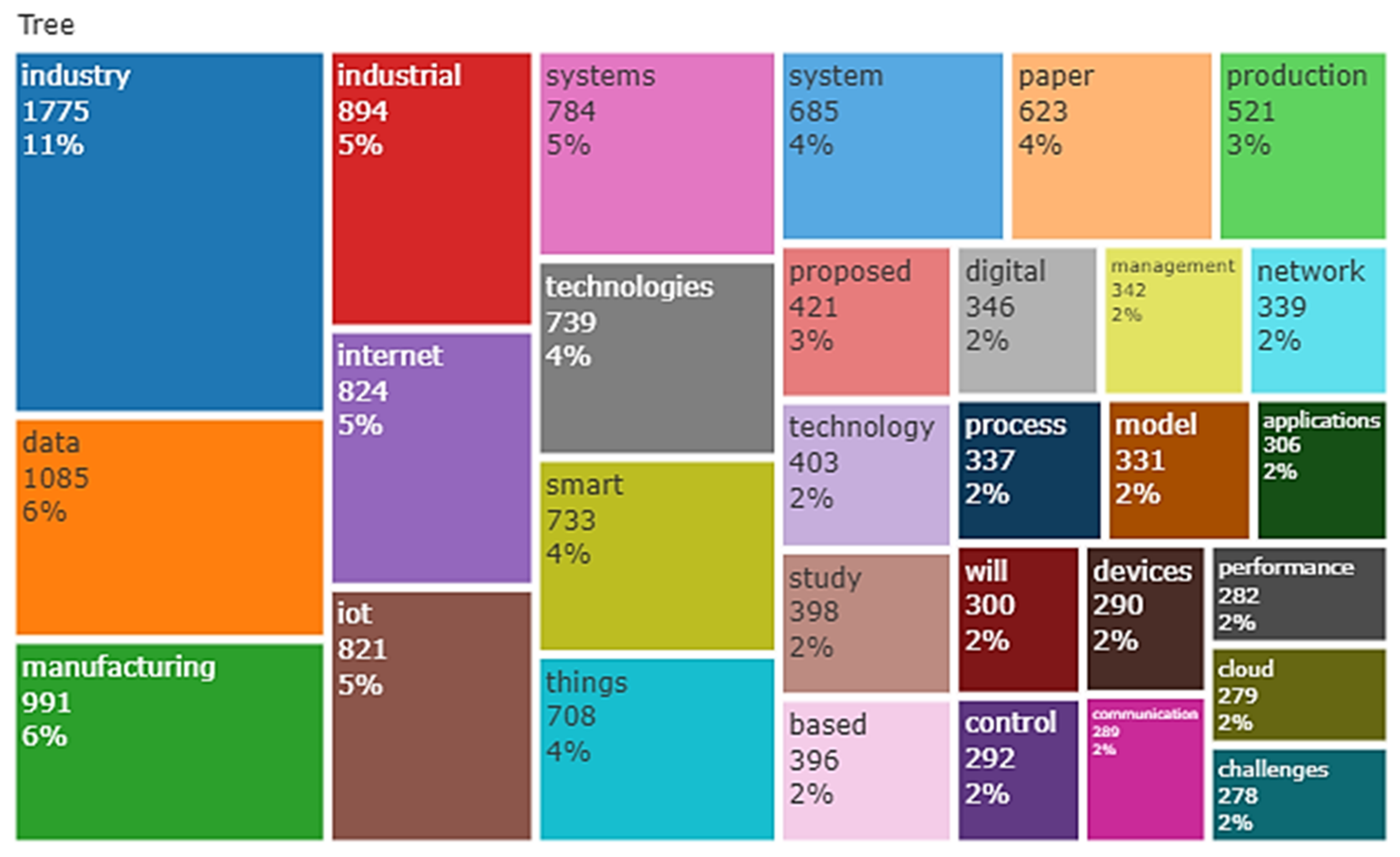
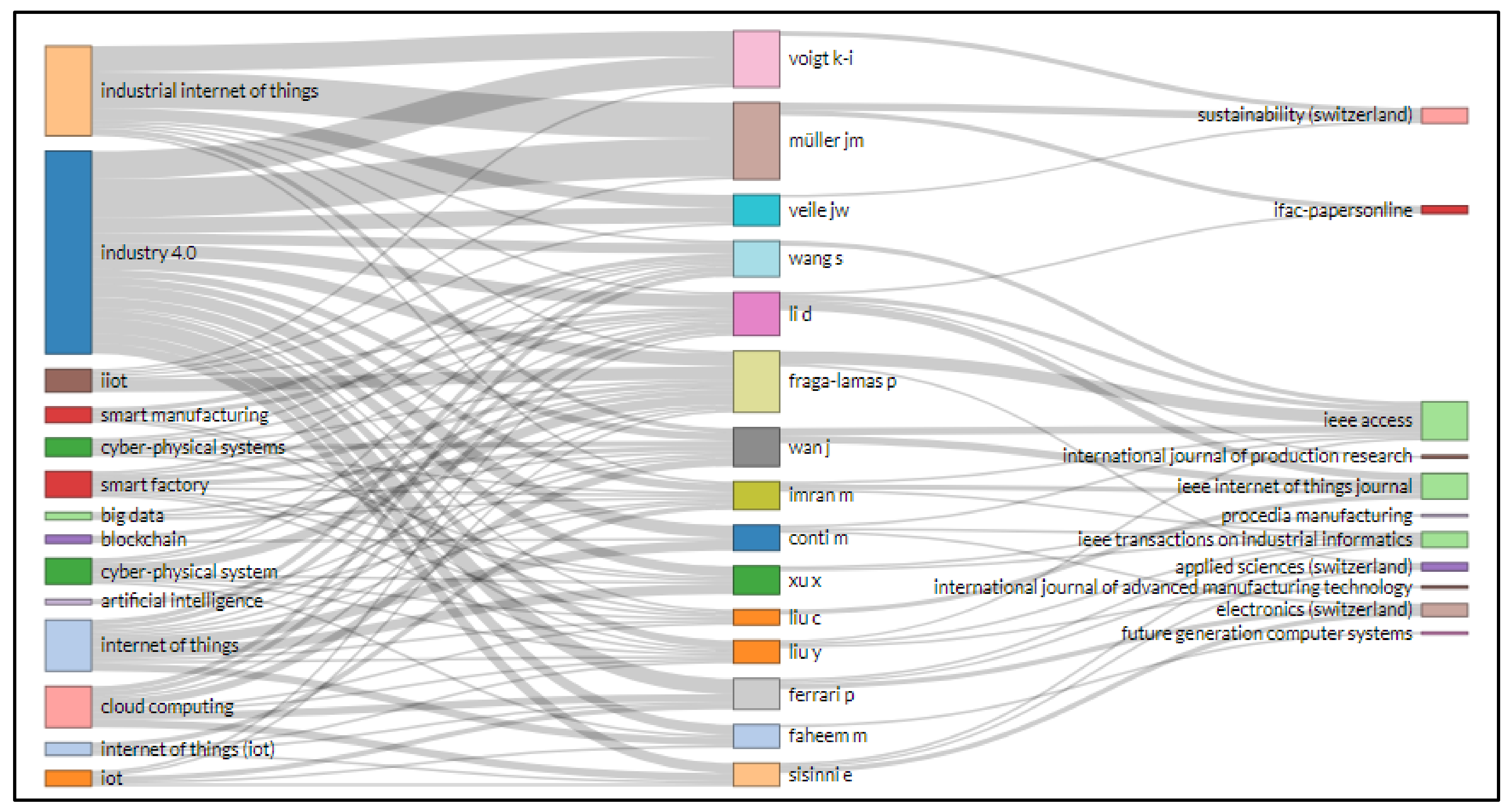
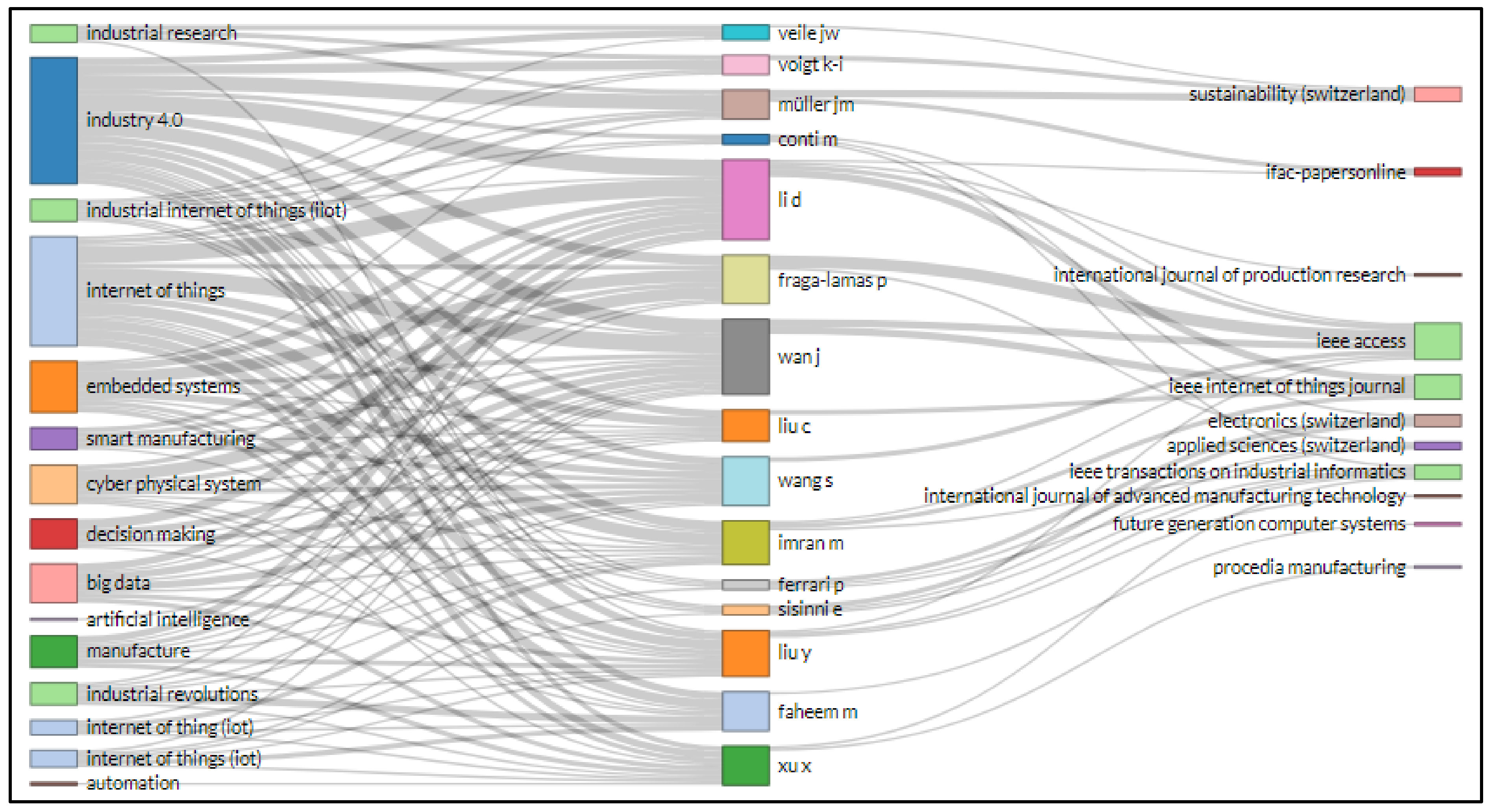
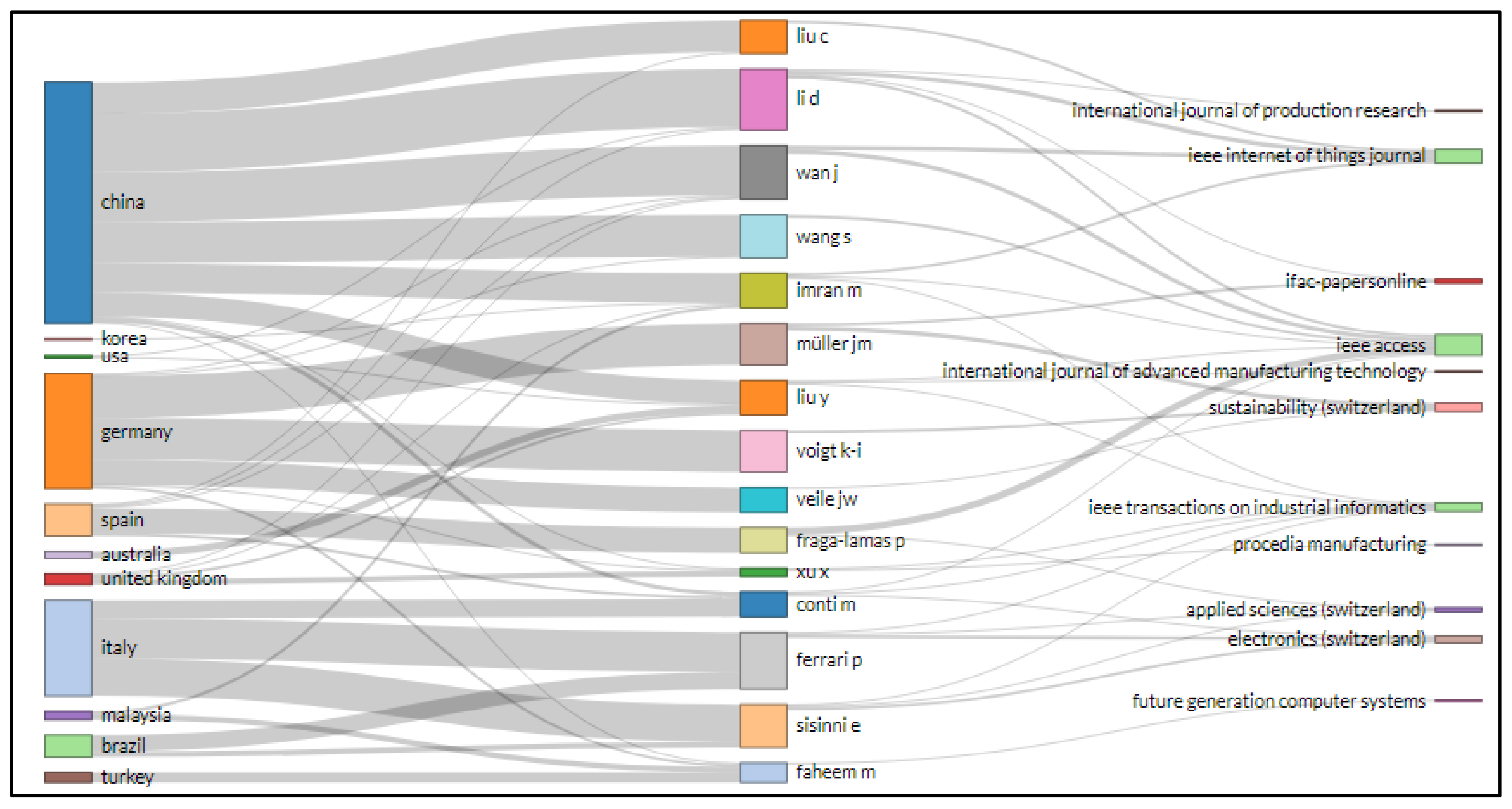
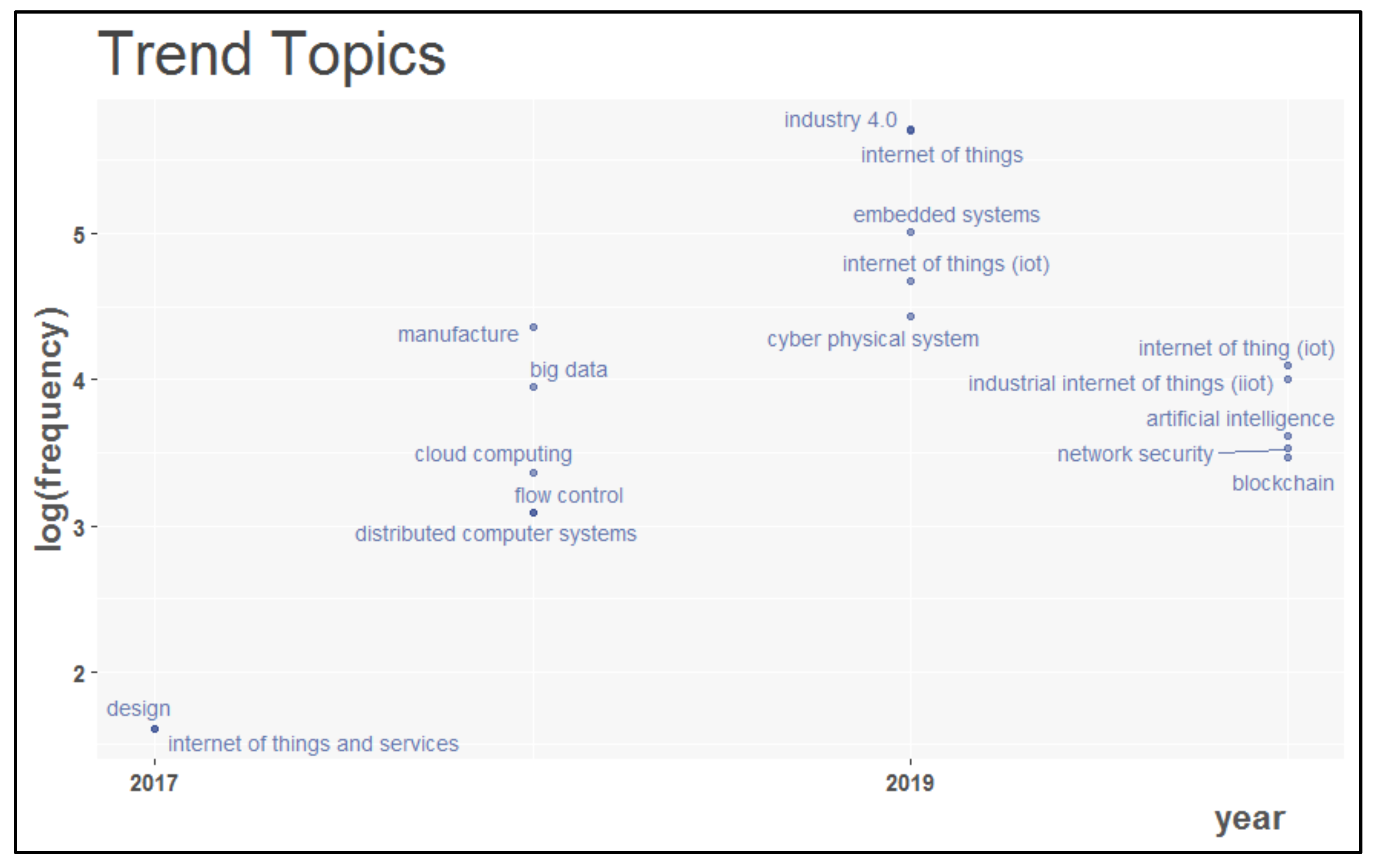

| Exploration Steps | Question on Scopus | Description | Count |
|---|---|---|---|
| 1 | TITLE-ABS-KEY | (“Internet of Things”) OR (“IoT”) OR (“Internet of Things (IoT)”) OR (“Industrial Internet of Things (IIoT)”) OR (“IIoT”) AND (“Industry 4.0”) | 3907 |
| 2 | AND (LIMIT-TO) | (LANGUAGE, “English”) | 3810 |
| 3 | AND (EXCLUDE) | (PUBYEAR,2021) | 3433 |
| 4 | AND (LIMIT-TO) | (DOCTYPE, “ar”) | 1014 |
| 5 | AND (EXCLUDE (SUBJAREA)) | (“PSYC”) OR (“EART”) OR (“HEAL”) OR (“PHAR”) OR (“IMMU”) OR (“MEDI”) | 891 |
| Parameter of Selection of a Paper | Inclusion Criterion | Exclusion Criterion | Rationale for Inclusion–Exclusion |
|---|---|---|---|
| Language | English | Rest all languages | The researchers and the preponderance of readership can readily understand English. |
| Year | 2014 to 2020 | Publications before 2014 and after 2020 | During this time, the majority of studies were carried out. There were only a few before 2014, and investigations after 2020 are in process. |
| Open Access | All | No Exclusion | All papers were essential. |
| Author Name | All | Discrimination on these grounds made no sense. | |
| Subject Area | All | Yes Exclusion | Not every subject area was important for evaluating IoT articles in Ind 4.0. |
| Keyword | All | No Exclusion | The keywords connected directly to the study were imperative. |
| Publication Status | All | All papers had to be added. | |
| Source Title | All | All journal titles were moderately pertinent. | |
| Affiliation | All | This structure did not violate the assortment criterion. | |
| Funding Sponsor | All | This structure did not violate the assortment criterion. | |
| Country | All | Publication from each country had its implications. | |
| Source Type | All | Yes Exclusion | Limited to journals, others were not entirely relevant. |
| Article Authors | ŤĈ | Rank on ŤĈ | ŤŁŜ | Rank on ŤŁŜ | ƤŜŷ | Ĉŷ | ŤĈ/ŷ | Rank on ŤĈ/ŷ | Ref. |
|---|---|---|---|---|---|---|---|---|---|
| Zhong R.Y., Xu X., Klotz E., Newman S.T. | 754 | 1 | 9 | 4 | 2017 | 3 | 251.3 | 3 | [59] |
| Xu L.D., Xu E.L., Li L. | 686 | 2 | 9 | 4 | 2018 | 2 | 343 | 1 | [32] |
| Wollschlaeger M., Sauter T., Jasperneite J. | 674 | 3 | 11 | 3 | 2017 | 3 | 224.7 | 4 | [61] |
| Kang H.S., Lee J.Y., Choi S., Kim H., Park J.H., Son J.Y., Kim B.H., Noh S.D. | 524 | 4 | 9 | 4 | 2016 | 4 | 131 | 7 | [62] |
| Hofmann E., Rüsch M. | 514 | 5 | 15 | 1 | 2017 | 3 | 171.3 | 5 | [60] |
| Wan J., Tang S., Shu Z., Li D., Wang S., Imran M., Vasilakos A.V. | 367 | 6 | 15 | 1 | 2016 | 4 | 91.75 | 10 | [63] |
| Frank A.G., Dalenogare L.S., Ayala N.F. | 320 | 7 | 7 | 7 | 2019 | 1 | 320 | 2 | [20] |
| Chen B., Wan J., Shu L., Li P., Mukherjee M., Yin B. | 314 | 8 | 2 | 10 | 2017 | 3 | 104.7 | 8 | [64] |
| Tao F., Zhang M. | 310 | 9 | 3 | 9 | 2017 | 3 | 103.3 | 9 | [65] |
| Moeuf A., Pellerin R., Lamouri S., Tamayo-Giraldo S., Barbaray R. | 276 | 10 | 4 | 8 | 2018 | 2 | 138 | 6 | [66] |
| Year | Technologies for Possible Integration | Domains | Evolution of Technology(s) | Ref. |
|---|---|---|---|---|
| 2017 | IoT, AI, Cloud Computing and CPS | Intelligent Manufacturing | No | [59] |
| 2018 | IoT, Cloud Computing and CPS | Security and Privacy | No | [32] |
| 2017 | IoT, CPS and ICT | Process Automation | No | [61] |
| 2016 | IoT | Smart Manufacturing | Yes | [62] |
| 2017 | IoT, CPS, and IoS | Smart Factory | No | [60] |
| 2019 | IoT, CPS, IIoT | Customizable Services | Yes-Partially | [67] |
| 2019 | IoT, Cloud Computing, and Big Data | Smart Manufacturing and Smart Supply Chain | No | [20] |
| 2017 | IoT, Cloud Computing, and Big Data | Manufacturing | No | [64] |
| 2017 | IoT, AI, Big Data | Digital Twin Shop-floor | NO | [65] |
| 2017 | IoT, CPS, M2M Communication | Production Planning in SMEs | Yes-Partially | [66] |
| 2016 | IoT | Lean Manufacturing | Yes | [68] |
| 2018 | IoT, CPS, Cloud Computing, and Simulation | Economic Stability and Sustainability | No | [69] |
| 2018 | IIoT, CPS | Industrial Connectivity | No | [70] |
| 2018 | IoT | Sustainability | No | [71] |
| 2018 | IoT | Circular Economy | No | [72] |
| 2017 | IoT and CPS | Business Strategies | No | [73] |
| 2018 | ICT, IoT, and CPS | Lean Manufacturing | No | [74] |
| 2018 | IoT, Big Data, and CPS | Resource Optimization | No | [75] |
| 2017 | IIoT | Electrical and Machine Industry | No | [76] |
| 2017 | IIoT | Supply Chain | Yes-Partially | [77] |
| 2019 | IoT, CPS, Big Data | Sustainability | No | [78] |
| 2018 | IIoT and Fog Computing, blockchain | Security and Communication Delays | No | [79] |
| 2017 | IoT | Smart Factory | No | [80] |
| 2016 | CPS | Manufacturing | No | [81] |
| 2015 | IoT | SMEs | No | [82] |
| Journals | ŤĈ | Rank on ŤĈ | NoA | Rank on NoA | ŤŁŜ | Rank on ŤŁŜ | ÄĈ | Rank on ÄĈ | ƤŜŷ | ĬF | CS |
|---|---|---|---|---|---|---|---|---|---|---|---|
| International Journal of Production Research | 1629 | 1 | 17 | 6 | 89 | 1 | 96 | 4 | 2018 | 4.577 | 7.6 |
| IEEE Access | 1470 | 2 | 53 | 1 | 52 | 5 | 28 | 9 | 2016 | 3.745 | 9.0 |
| Computers in Industry | 1247 | 3 | 17 | 6 | 71 | 2 | 73 | 5 | 2016 | 3.954 | 10 |
| Procedia Manufacturing | 1075 | 4 | 20 | 5 | 61 | 4 | 54 | 6 | 2015 | - | 1.9 |
| Sustainability (Switzerland) | 973 | 5 | 28 | 2 | 64 | 3 | 35 | 7 | 2017 | 2.576 | 3.9 |
| Engineering | 939 | 6 | 3 | 8 | 36 | 6 | 313 | 1 | 2017 | 6.495 | 8.2 |
| IEEE Transactions on Industrial Informatics | 859 | 7 | 28 | 2 | 30 | 8 | 31 | 8 | 2017 | 9.112 | 13.9 |
| IEEE Industrial Electronics Magazine | 710 | 8 | 3 | 8 | 27 | 9 | 237 | 3 | 2017 | 13.593 | 16.4 |
| International Journal of Precision Engineering and Manufacturing Green Technology | 602 | 9 | 2 | 10 | 15 | 10 | 301 | 2 | 2016 | 4.171 | 7.5 |
| IFAC-PapersOnLine | 601 | 10 | 28 | 2 | 33 | 7 | 21 | 10 | 2016 | - | 1.6 |
| Author | ŤĈ | Rank on ŤĈ | NoA | Rank on NoA | ŤŁŜ | Rank on ŤŁŜ | ÄĈ | Rank on ÄĈ | h_index | g_index | m_index | ƤŜŷ |
|---|---|---|---|---|---|---|---|---|---|---|---|---|
| Wan J. | 1031 | 1 | 8 | 3 | 132 | 2 | 129 | 8 | 7.000 | 8.000 | 1.167 | 2016 |
| Li D. | 946 | 2 | 11 | 2 | 142 | 1 | 86 | 9 | 9.000 | 11.000 | 1.500 | 2016 |
| Xu L.D. | 907 | 3 | 4 | 5 | 43 | 6 | 227 | 6 | 4.000 | 4.000 | 1.000 | 2018 |
| Xu X. | 903 | 4 | 5 | 4 | 50 | 4 | 181 | 7 | 4.000 | 5.000 | 0.571 | 2015 |
| Zhong R.Y. | 803 | 5 | 3 | 6 | 50 | 4 | 268 | 5 | 3.000 | 3.000 | 0.600 | 2017 |
| Müller J.M. | 732 | 6 | 15 | 1 | 84 | 3 | 49 | 10 | 1.000 | 1.000 | 0.200 | 2017 |
| Li L. | 689 | 7 | 2 | 7 | 33 | 10 | 345 | 1 | 1.000 | 1.000 | 0.200 | 2017 |
| Jasperneite J. | 680 | 8 | 2 | 7 | 35 | 7 | 340 | 2 | 9.000 | 15.000 | 1.800 | 2017 |
| Sauter T. | 680 | 8 | 2 | 7 | 35 | 7 | 340 | 2 | 2.000 | 2.000 | 0.500 | 2018 |
| Wollschlaeger M. | 680 | 8 | 2 | 7 | 35 | 7 | 340 | 2 | 1.000 | 1.000 | 0.250 | 2018 |
| Organizations | ŤĈ | Rank on ŤĈ | NoA | Rank on NoA | ŤŁŜ | Rank on ŤŁŜ | ÄĈ | Rank on ÄĈ |
|---|---|---|---|---|---|---|---|---|
| South China University of Technology, Guangzhou, China | 788 | 1 | 4 | 1 | 17 | 1 | 197 | 2 |
| Beihang University, Beijing, China | 439 | 2 | 2 | 3 | 1 | 8 | 220 | 1 |
| Universidade Federal Do Rio Grande Do Sul, Brazil | 359 | 3 | 3 | 2 | 2 | 4 | 120 | 4 |
| California State University, United States | 267 | 4 | 2 | 3 | 4 | 2 | 134 | 3 |
| Campus Universitário De Santiago, Portugal | 233 | 5 | 2 | 3 | 1 | 8 | 117 | 5 |
| North-West University, South Africa | 224 | 6 | 2 | 3 | 2 | 4 | 112 | 6 |
| Friedrich-Alexander University Erlangen-Nürnberg, Germany | 213 | 7 | 2 | 3 | 3 | 3 | 107 | 7 |
| Ierg, University College Cork, Ireland | 189 | 8 | 2 | 3 | 2 | 4 | 95 | 8 |
| Federal University of Rio Grande Do Sul, Porto Alegre, Brazil | 164 | 9 | 2 | 3 | 1 | 8 | 82 | 9 |
| Vit University, Vellore, India | 147 | 10 | 2 | 3 | 2 | 4 | 74 | 10 |
| Nations | ŤĈ | Rank on ŤĈ | NoA | Rank on NoA | ŤŁŜ | Rank on ŤŁŜ | ÄĈ | Rank on ÄĈ |
| Germany | 4172 | 1 | 90 | 2 | 337 | 1 | 46 | 2 |
| United Kingdom | 3247 | 2 | 66 | 6 | 287 | 4 | 49 | 1 |
| United States | 3039 | 3 | 95 | 1 | 313 | 2 | 32 | 6 |
| China | 2951 | 4 | 83 | 4 | 250 | 5 | 36 | 5 |
| Italy | 1483 | 5 | 84 | 3 | 179 | 7 | 18 | 8 |
| India | 1440 | 6 | 82 | 5 | 299 | 3 | 18 | 9 |
| Brazil | 1205 | 7 | 44 | 8 | 214 | 6 | 27 | 7 |
| Austria | 1094 | 8 | 25 | 10 | 115 | 10 | 44 | 3 |
| Spain | 1093 | 9 | 65 | 7 | 131 | 9 | 17 | 10 |
| France | 1062 | 10 | 28 | 9 | 132 | 8 | 38 | 4 |
| Year | 2014 | 2015 | 2016 | 2017 | 2018 | 2019 | 2020 | Sum | Avg. |
|---|---|---|---|---|---|---|---|---|---|
| Industry 4.0 | 1 | 8 | 21 | 44 | 93 | 142 | 219 | 528 | 132 |
| Internet of Things | 0 | 3 | 10 | 23 | 52 | 50 | 82 | 220 | 55 |
| IoT | 0 | 2 | 4 | 4 | 17 | 35 | 42 | 104 | 26 |
| Industrial Internet of Things | 0 | 0 | 1 | 3 | 9 | 20 | 34 | 67 | 17 |
| Cyber-Physical Systems | 0 | 1 | 6 | 9 | 17 | 16 | 15 | 64 | 16 |
| Internet of Things (IoT) | 0 | 0 | 4 | 1 | 11 | 16 | 31 | 63 | 16 |
| Big Data | 0 | 1 | 1 | 4 | 10 | 20 | 21 | 57 | 14 |
| Smart Manufacturing | 0 | 1 | 2 | 8 | 13 | 13 | 16 | 53 | 13 |
| Smart Factory | 0 | 0 | 4 | 7 | 10 | 10 | 14 | 45 | 11 |
| Cloud Computing | 0 | 0 | 2 | 3 | 9 | 11 | 16 | 41 | 10 |
| Year | 2015 | 2016 | 2017 | 2018 | 2019 | 2020 | Sum | Avg. |
|---|---|---|---|---|---|---|---|---|
| Industry 4.0 | 0 | 8 | 9 | 72 | 86 | 127 | 302 | 50 |
| Internet of Things | 3 | 18 | 17 | 86 | 77 | 99 | 300 | 50 |
| Embedded Systems | 3 | 12 | 22 | 37 | 38 | 38 | 150 | 25 |
| Internet of Things (IoT) | 1 | 6 | 6 | 25 | 29 | 40 | 107 | 18 |
| Cyber Physical System | 0 | 7 | 14 | 20 | 29 | 14 | 84 | 14 |
| Manufacture | 1 | 7 | 17 | 18 | 16 | 19 | 78 | 13 |
| Industrial Revolutions | 1 | 6 | 4 | 17 | 13 | 34 | 75 | 13 |
| Decision Making | 1 | 7 | 5 | 11 | 9 | 30 | 63 | 11 |
| Internet of Thing (IoT) | 0 | 2 | 3 | 11 | 12 | 32 | 60 | 10 |
| Industrial Internet of Things (IioT) | 0 | 0 | 0 | 1 | 4 | 50 | 55 | 9 |
| Rank | Term | Occ | RS | Rank | Term | Occ | RS |
|---|---|---|---|---|---|---|---|
| 1 | Application | 282 | 0.407 | 1 | Design Methodology Approach | 34 | 8.432 |
| 2 | Study | 215 | 0.856 | 2 | Originality Value | 36 | 7.665 |
| 3 | Network | 210 | 1.230 | 3 | IoT Device | 41 | 3.906 |
| 4 | Solution | 197 | 0.485 | 4 | Manager | 46 | 2.262 |
| 5 | Research | 195 | 0.686 | 5 | Protocol | 60 | 2.225 |
| 6 | Device | 183 | 1.523 | 6 | Gap | 46 | 1.896 |
| 7 | Manufacturing | 179 | 0.183 | 7 | Sustainability | 46 | 1.863 |
| 8 | Service | 165 | 0.371 | 8 | Factor | 72 | 1.649 |
| 9 | Cyber-Physical System | 164 | 0.436 | 9 | New Technology | 42 | 1.606 |
| 10 | Time | 155 | 0.291 | 10 | Researcher | 34 | 1.590 |
| 11 | Industrial Internet | 143 | 0.877 | 11 | Innovation | 60 | 1.565 |
| 12 | Integration | 141 | 0.246 | 12 | Organization | 68 | 1.565 |
| 13 | Requirement | 141 | 0.392 | 13 | Reliability | 50 | 1.548 |
| 14 | Company | 137 | 1.377 | 14 | Device | 183 | 1.523 |
| 15 | Architecture | 133 | 0.547 | 15 | Deployment | 52 | 1.511 |
| 16 | Communication | 122 | 1.372 | 16 | Algorithm | 69 | 1.435 |
| 17 | Control | 120 | 0.540 | 17 | Literature | 84 | 1.410 |
| 18 | Production | 119 | 0.252 | 18 | Smart City | 34 | 1.409 |
| 19 | Machine | 118 | 0.365 | 19 | Scenario | 89 | 1.407 |
| 20 | Problem | 115 | 0.280 | 20 | Company | 137 | 1.377 |
| 21 | Sensor | 114 | 0.882 | 21 | Communication | 122 | 1.372 |
| 22 | Platform | 110 | 0.562 | 22 | Number | 84 | 1.346 |
| 23 | Big Data | 108 | 0.423 | 23 | User | 62 | 1.304 |
| 24 | Change | 104 | 0.650 | 24 | Monitoring | 88 | 1.302 |
| 25 | Fourth Industrial Revolution | 99 | 0.248 | 25 | Business | 45 | 1.287 |
| Year | Industry | Smart | Manufacturing | Industrial | Internet | Things | Systems | IoT | Data | System |
|---|---|---|---|---|---|---|---|---|---|---|
| 2014 | 2 | 0 | 0 | 0 | 1 | 1 | 0 | 0 | 0 | 0 |
| 2015 | 8 | 3 | 5 | 4 | 3 | 4 | 3 | 2 | 2 | 1 |
| 2016 | 22 | 9 | 13 | 9 | 11 | 6 | 5 | 5 | 3 | 6 |
| 2017 | 34 | 16 | 13 | 6 | 6 | 6 | 14 | 7 | 4 | 7 |
| 2018 | 77 | 31 | 30 | 24 | 23 | 21 | 18 | 19 | 15 | 11 |
| 2019 | 96 | 39 | 41 | 26 | 26 | 26 | 27 | 18 | 23 | 14 |
| 2020 | 155 | 52 | 47 | 58 | 42 | 38 | 26 | 39 | 23 | 31 |
| Sum | 394 | 150 | 149 | 127 | 112 | 102 | 93 | 90 | 70 | 70 |
| Avg. | 99 | 38 | 37 | 32 | 28 | 26 | 23 | 23 | 18 | 18 |
| Year | Industry | Data | Manufacturing | Industrial | Internet | IoT | Systems | Technologies | Smart | Things |
|---|---|---|---|---|---|---|---|---|---|---|
| 2014 | 0 | 0 | 0 | 0 | 2 | 0 | 2 | 0 | 0 | 1 |
| 2015 | 20 | 16 | 23 | 10 | 15 | 3 | 12 | 12 | 19 | 11 |
| 2016 | 76 | 24 | 61 | 48 | 39 | 28 | 44 | 31 | 36 | 28 |
| 2017 | 137 | 48 | 139 | 54 | 64 | 35 | 81 | 51 | 66 | 56 |
| 2018 | 378 | 180 | 210 | 176 | 163 | 139 | 161 | 151 | 155 | 140 |
| 2019 | 435 | 311 | 226 | 219 | 223 | 223 | 198 | 203 | 172 | 187 |
| 2020 | 729 | 506 | 332 | 387 | 318 | 393 | 286 | 291 | 285 | 285 |
| Sum | 1775 | 1085 | 991 | 894 | 824 | 821 | 784 | 739 | 733 | 708 |
| Avg. | 444 | 271 | 248 | 224 | 206 | 205 | 196 | 185 | 183 | 177 |
Publisher’s Note: MDPI stays neutral with regard to jurisdictional claims in published maps and institutional affiliations. |
© 2022 by the authors. Licensee MDPI, Basel, Switzerland. This article is an open access article distributed under the terms and conditions of the Creative Commons Attribution (CC BY) license (https://creativecommons.org/licenses/by/4.0/).
Share and Cite
Kumar, R.; Rani, S.; Awadh, M.A. Exploring the Application Sphere of the Internet of Things in Industry 4.0: A Review, Bibliometric and Content Analysis. Sensors 2022, 22, 4276. https://doi.org/10.3390/s22114276
Kumar R, Rani S, Awadh MA. Exploring the Application Sphere of the Internet of Things in Industry 4.0: A Review, Bibliometric and Content Analysis. Sensors. 2022; 22(11):4276. https://doi.org/10.3390/s22114276
Chicago/Turabian StyleKumar, Raman, Sita Rani, and Mohammed Al Awadh. 2022. "Exploring the Application Sphere of the Internet of Things in Industry 4.0: A Review, Bibliometric and Content Analysis" Sensors 22, no. 11: 4276. https://doi.org/10.3390/s22114276
APA StyleKumar, R., Rani, S., & Awadh, M. A. (2022). Exploring the Application Sphere of the Internet of Things in Industry 4.0: A Review, Bibliometric and Content Analysis. Sensors, 22(11), 4276. https://doi.org/10.3390/s22114276







